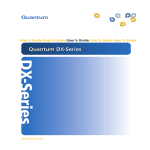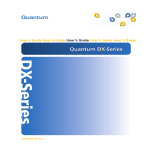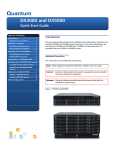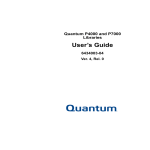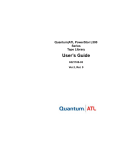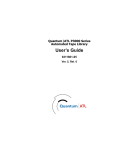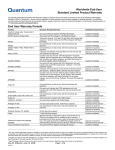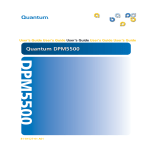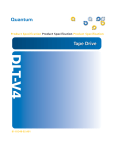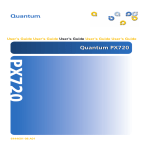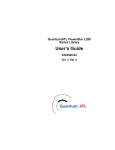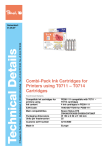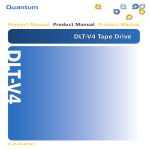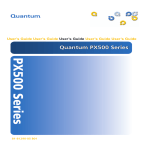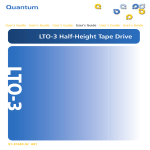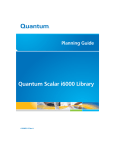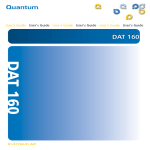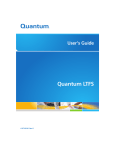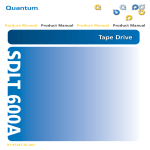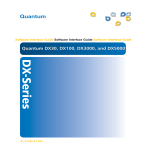Download Quantum DX5000 User's Guide
Transcript
8VHU¶V*XLGH8VHU¶V*XLGH8VHU¶V*XLGH8VHU¶V*XLGH8VHU¶V*XLGH 4XDQWXP';DQG'; ';6HULHV % Quantum DX3000 and DX5000 User’s Guide, 81-81493-03 B01, June 2006, Made in USA. Quantum Corporation provides this publication “as is” without warranty of any kind, either express or implied, including but not limited to the implied warranties of merchantability or fitness for a particular purpose. Quantum Corporation may revise this publication from time to time without notice. COPYRIGHT STATEMENT Copyright 2006 by Quantum Corporation. All rights reserved. Your right to copy this manual is limited by copyright law. Making copies or adaptations without prior written authorization of Quantum Corporation is prohibited by law and constitutes a punishable violation of the law. TRADEMARK STATEMENT DLT and DLTtape are trademarks of Quantum Corporation. Quantum, the Quantum logo, and the DLTtape logo are all registered trademarks of Quantum Corporation. Other trademarks may be mentioned herein which belong to other companies. Contents Preface xi StorageCare Guardian.................................................................................... xvi Chapter 1 DX3000 and DX5000 System Description 1 Overview..............................................................................................................1 Time Required for Backup .........................................................................2 Confidence in Completing the Backup ....................................................2 Time to Restore Data...................................................................................2 Features and Benefits .........................................................................................2 DX3000 and DX5000 Systems ...........................................................................4 DX3000 System Components.....................................................................5 DX5000 System Components.....................................................................6 Hard Drive Storage ............................................................................................8 RAID Sets....................................................................................................10 Supported RAID Configurations ...................................................................10 RAID 5 Configuration...............................................................................11 Typical Configurations ....................................................................................11 Quantum DX3000 and DX5000 User’s Guide iii Contents Chapter 2 Basic Operations 13 Turning on the System.....................................................................................13 Turning on the DX3000 ............................................................................14 Turning on the DX5000 ............................................................................14 DX3000/DX5000 Operations ..........................................................................15 Chassis LEDs and Buttons .......................................................................15 Hard Drive Sled LEDs ..............................................................................18 Ethernet Port LEDs ...................................................................................18 Power Supply LED....................................................................................19 Relocating the DX3000 and DX5000 Systems...............................................21 Chapter 3 DX3000 and DX5000 Remote Management 22 DX3000 and DX5000 Web Pages ....................................................................23 DX3000 and DX5000 Web Page Menu Items ........................................23 Accessing DX3000 and DX5000 Web Pages ..........................................24 Using the DX3000 and DX5000 Web Pages ...........................................26 Configuration....................................................................................................28 Accessing Library Configuration............................................................28 Configuring the Media .............................................................................30 Configuring the Library ...........................................................................35 Configuring the Network ........................................................................44 Configuring the Date and Time ..............................................................46 Configuring the Security Options...........................................................47 Configuring System Hardware ...............................................................52 System Status ....................................................................................................62 Accessing System Status ..........................................................................63 Viewing Tape Drive Details.....................................................................64 Viewing Robot Details..............................................................................66 Viewing Storage Bin Details ....................................................................67 Viewing Virtual Disk Status ....................................................................69 Viewing Hardware Status........................................................................70 Viewing Media Status...............................................................................71 Remote Alerts....................................................................................................72 Accessing Remote Alerts..........................................................................72 Licensing............................................................................................................82 Quantum DX3000 and DX5000 User’s Guide iv Contents Utilities...............................................................................................................83 Accessing Utilities .....................................................................................83 Changing Library State ............................................................................84 System Log .................................................................................................84 Uploading Firmware ................................................................................86 System Configuration...............................................................................87 Downloading the System Diagnostics File............................................90 Rebooting the DX3000/DX5000 System ................................................91 Chapter 4 Troubleshooting 93 Common Problems and Solutions .................................................................93 Hardware Problems..................................................................................93 Ethernet Network Problems ....................................................................94 Appendix A DX3000/DX5000 System Specifications 96 Physical Characteristics ...................................................................................97 Performance Characteristics ...........................................................................98 Environmental Specifications .........................................................................98 Appendix B Regulatory Statements 100 Disposal of Electrical and Electronic Equipment ......................................105 Glossary 106 Index 109 Quantum DX3000 and DX5000 User’s Guide v Figures Figure 1 DX3000 System ..............................................................................4 Figure 2 DX5000 System ..............................................................................4 Figure 3 DX3000 System Components ......................................................6 Figure 4 DX5000 System Components ......................................................7 Figure 5 DX3000 and DX5000 Hard Drives ..............................................8 Figure 6 RAID 5 Configuration ................................................................11 Figure 7 DX3000/DX5000 System Plus a Tape Library ........................12 Figure 8 Turning on the DX3000 ..............................................................14 Figure 9 Turning on the DX5000 ..............................................................14 Figure 10 DX3000 LED Indicators ..............................................................15 Figure 11 DX5000 LED Indicators ..............................................................17 Figure 12 Hard Drive Sled LEDs ................................................................18 Figure 13 Ethernet Port LEDs .....................................................................19 Figure 14 Power Supply LED Indicators...................................................20 Figure 15 DX3000 and DX5000 Web Page Menu Items ..........................24 Figure 16 Login Page....................................................................................25 Figure 17 Home Page ...................................................................................26 Quantum DX3000 and DX5000 User’s Guide vi Figures Figure 18 Configuration Page.....................................................................29 Figure 19 Media Screen ...............................................................................30 Figure 20 Edit Volume Media Area Screen ..............................................31 Figure 21 Tape Cartridges Screen ..............................................................32 Figure 22 Virtual Disks Area Screen..........................................................34 Figure 23 Partitions Page.............................................................................36 Figure 24 Adding a Partition ......................................................................37 Figure 25 Editing a Partition.......................................................................39 Figure 26 Enabling/Disabling Write Protection......................................41 Figure 27 Assigning Barcode Labels..........................................................42 Figure 28 Assigning a Library Name ........................................................44 Figure 29 Network Configuration Page....................................................45 Figure 30 Date and Time Configuration ...................................................47 Figure 31 Security Configuration...............................................................48 Figure 32 SSL Configuration.......................................................................50 Figure 33 Install SSL Certificate Page........................................................51 Figure 34 Device Mapping Page ................................................................53 Figure 35 iSCSI Ethernet Input Port Locations ........................................55 Figure 36 iSCSI Configuration Page ..........................................................56 Figure 37 Fibre Channel Configuration ....................................................58 Figure 38 RAID Configuration Screen (DX5000 Shown)........................60 Figure 39 Hard Drive Numbering .............................................................62 Figure 40 System Status Page .....................................................................63 Figure 41 Tape Drive Details ......................................................................65 Figure 42 Robot Details ...............................................................................66 Figure 43 Storage Bin Details......................................................................68 Figure 44 Virtual Disk Status Page ............................................................69 Figure 45 Hardware Status Page................................................................70 Figure 46 Media Status Page.......................................................................71 Quantum DX3000 and DX5000 User’s Guide vii Figures Figure 47 Remote Alerts Page ....................................................................73 Figure 48 Email Tab .....................................................................................74 Figure 49 SNMP Tab ....................................................................................76 Figure 50 SNMP Trap Destinations ...........................................................78 Figure 51 SNMP Community Management.............................................79 Figure 52 Contacts Tab ................................................................................80 Figure 53 End User Agreement Tab ..........................................................83 Figure 54 Utilities Page................................................................................84 Figure 55 System Log...................................................................................85 Figure 56 Uploading Firmware..................................................................86 Figure 57 Activating/ Removing a Firmware Image..............................87 Figure 58 Downloading Configuration Files............................................88 Figure 59 Activating the Configuration File.............................................90 Figure 60 Downloading Diagnostics Files ................................................91 Figure 61 Shutting Down the DX3000/DX5000 System.........................92 Quantum DX3000 and DX5000 User’s Guide Tables Table 1 DX3000/DX5000 Capacity Specifications..................................5 Table 2 DX3000 LEDs ...............................................................................16 Table 3 DX5000 LEDs ...............................................................................17 Table 4 Drive Sled LEDs ..........................................................................18 Table 5 Ethernet Port LEDs .....................................................................19 Table 6 Power Supply LED .....................................................................20 Table 7 Network Configuration Fields ..................................................45 Table 8 Port Settings .................................................................................59 Table 9 RAID Configurations..................................................................60 Table 10 Tape Drive Details ......................................................................65 Table 11 Robot Details................................................................................67 Table 12 Storage Bin Details ......................................................................68 Table 13 Logical Drive Status....................................................................69 Table 14 Email Notification .......................................................................74 Table 15 Email Server Information...........................................................75 Table 16 SNMP Trap Selections ................................................................77 Table 17 Company Information................................................................81 Quantum DX3000 and DX5000 User’s Guide ix Tables Table 18 Primary/Secondary Contact Information...............................81 Table 19 Hardware Problems ...................................................................94 Table 20 Ethernet Network Problems......................................................95 Table 21 Physical Characteristics .............................................................97 Table 22 Interfaces ......................................................................................97 Table 23 Performance Characteristics......................................................98 Table 24 Environmental Specifications ...................................................98 Quantum DX3000 and DX5000 User’s Guide x Preface This manual introduces the Quantum DX3000 and DX5000 enhanced data protection systems and discusses: • System operations • Configuration • Web interface • Basic troubleshooting Audience This manual is written for DX3000 and DX5000 system operators and field service engineers. Document Organization Following is a brief description of chapter contents. • Chapter 1, “DX3000 and DX5000 System Description,” provides an overview of the DX3000/DX5000 system. • Chapter 2, “Basic Operations,” provides basic operating instructions for the DX3000/DX5000 system. • Chapter 3, “DX3000 and DX5000 Remote Management,” discusses using the DX3000/DX5000 system management pages to control the system remotely. Quantum DX3000 and DX5000 User’s Guide xi Notational Conventions • Chapter 4, “Troubleshooting,” discusses problems you may encounter during the setup and operation of the DX3000/DX5000 system. • The Appendices provide system specifications, event handling, and regulatory statements. This manual uses the following conventions: Caution: Caution indicates potential hazards to equipment or data. Warning: Warning indicates potential hazards to personal safety. Note: Note emphasizes important information related to the main topic. Tech Tip: Tech tip provides additional technical information that may assist in installation and configuration. • Right side of the system — Refers to the right side as you face the component being described. • Left side of the system — Refers to the left side as you face the component being described. • b — All binary numbers are succeeded by “b.” • h — All hexadecimal numbers are succeeded by “h.” • Error or attention conditions are represented in parenthesis that translate as follows: (SK=S ASC=AA ASCQ=QQ) where: S — hexadecimal sense key value AA — hexadecimal additional sense code QQ — hexadecimal additional sense code qualifiers Quantum DX3000 and DX5000 User’s Guide xii Related Documents Supported Internet Browsers The following Quantum document are also available for the DX3000 and DX5000 systems: Document Description Document No. Document Title 81-81492 Quantum DX3000 and DX5000 Quick Start Guide Describes unpacking and installing both the DX3000 and DX5000 systems 81-81494 Quantum DX3000/ DX5000/DPM5500 Hard Drive Upgrade Instructions Describes upgrading your DX3000 or DX5000 hard drives. 81-81503 Quantum DX3000/ DX5000/DPM5500 Fan Replacement Instructions Describes replacing your DX3000 or DX5000 cooling fans. 81-81504 Quantum DX3000/ DX5000/DPM5500 Power Supply Replacement Instructions Describes replacing your DX3000 or DX5000 power supplies. 81-81506 Quantum DX3000/ DX5000/DPM5500 Hard Drive Replacement Instructions Describes replacing your DX3000 or DX5000 hard drives. 81-81507 Quantum DX3000/ DX5000/DPM5500 Chassis Replacement Instructions Describes replacing your DX3000 or DX5000 chassis. The Internet browser software is not supplied with the DX3000/DX5000 system; you must obtain and install it independently. The DX3000/DX5000 system supports the following Internet browsers: Quantum DX3000 and DX5000 User’s Guide xiii • Microsoft Internet Explorer 6.0 SP1 or later You can download this software from http://www.microsoft.com. Note: If Internet Explorer is the default browser on the client system: • The latest security updates for Microsoft VM (virtual machine) must be installed on the client system. • The security settings must be set no higher than “medium”. If the settings are set to “high security”, the browser will not be able to login to the DX-Series system since the system needs write access to the client. • The “Play animations in web pages” item in the Internet Options/Advanced/Multimedia menu must be enabled. • Mozilla Suite 1.7 on Solaris 10 You can download this software from http://www.mozilla.org. • Firefox 1.0.6 on Windows You can download this software from http://www.mozilla.org. • Java Plug-in 1.4.2 or later You can download this software from http://www.java.com 0 SCSI-2 Specification The SCSI-2 communications specification is the proposed American National Standard for information systems, dated March 9, 1990. Copies may be obtained from: Global Engineering Documents 15 Inverness Way, East Englewood, CO 80112 (800) 854-7179 or (303) 397-2740 Quantum DX3000 and DX5000 User’s Guide xiv Contacts Quantum company contacts are listed below. 0 Quantum Quantum P.O. Box 57100 Irvine, CA 92619-7100 (949) 856-7800 (800) 284-5101 0 Technical Publications To comment on existing documentation send e-mail to: [email protected] 0 Visit the Quantum home page at: http://www.Quantum.com 0 Customer Support The Quantum Customer Support Department provides a 24-hour help desk that can be reached at: North/South America: (949) 725-2100 or (800) 284-5101 Asia/Pacific Rim: (International Code) +61 7 3862 4834 Europe/Middle East/Africa: (International Code) +44 (0) 1256 848748 Send faxes for the Customer Support Department to: North/South America: (949) 725-2176 Asia/Pacific Rim: (International Code) +61 7 3862 4677 Europe/Middle East/Africa: (International Code) +44 (0) 1256 848777 Quantum DX3000 and DX5000 User’s Guide xv StorageCare Guardian To contact the Customer Support Department use the following web/ addresses: North/South America: www.quantum.com/askaquestion Asia/Pacific Rim: [email protected] Europe/Middle East/Africa: [email protected] E-mail StorageCare Guardian 0 StorageCare Guardian is a remote monitoring and diagnostic solution that enables Quantum to proactively monitor the health of Quantum products, use diagnostic data to predict possible failures, and determine whether or not the problem involves a Quantum product or other critical component in the environment. Benefits StorageCare Guardian gives the customer added assurance that Quantum will make sure its products are running optimally to ensure maximum operational efficiency. Deploying this solution is easy and enables customers to minimize the costs associated with system downtime and service issues should a problem arise. More Reliable Backups Through continuous 24x7x365 monitoring, StorageCare Guardian proactively checks Quantum systems for common errors and alerts the customer when a Quantum product is underperforming. By proactively identifying red flags, the risk of failed backups and machine downtime can be mitigated. Faster Resolution Time When the system is down, StorageCare Guardian provides the necessary diagnostics data that enables Quantum to identify the root cause and expedite the problem resolution process. Problems that used to take days to fix can now be fixed in minutes. When problems require onsite support, field engineers will have better information along with the right parts necessary to fix the problem. 0 StorageCare Guardian allows Quantum to • Monitor diagnostic data related to Quantum products • Receive alarms that notify Quantum of issues at the customer site Quantum DX3000 and DX5000 User’s Guide xvi StorageCare Guardian • Run diagnostic utilities to more quickly determine the root cause of issues • Initiate remote connection to remote management interface to get more indepth information about the health of your Quantum product. • Distribute software/firmware upgrades - this will be available as a future enhancement 0 Product Features • Continuous Monitoring - Proactive 7x24x365 monitoring of Quantum products enabling Quantum Support to be alerted on events such as errors or marginal conditions that are defined by the user. • Root Cause Diagnosis - Allows Quantum to quickly isolate and identify the root cause of a problem. • Rapid Problem Resolution- Quantum can rapidly recommend and/or implement the corrective actions needed to resolve a problem ensuring minimal impact to the IT environment. • Quantum Remote Software Update - Distributed software update capability allows fast updates to agent software and Quantum hardware installed at customer sites • Real-time Data Collection - Instant on-demand or scheduled diagnostic data collection from Quantum products as well as the ability to run user-defined data collection scripts from agent. • Access Management - Customer has full control over Quantum's access rights and privileges. • Audit Logging - Audit logs are kept for all communications to and from the agent. 0 How it works: 1 Customers can download the StorageCare Guardian agent software from http://www.quantum.com/guardiandownload. 2 Customer installs the StorageCare Guardian agent on any Windows 2000/ 2003/XP or Solaris 8/9 server located at the customer’s site. 3 The StorageCare Guardian agent monitors Quantum products, and provides information and updates to the Quantum Enterprise Server that resides at Quantum Support. 4 If an error or problem is detected, Quantum queues a request to the StorageCare Guardian agent for data collection or real-time access to the system. Quantum DX3000 and DX5000 User’s Guide xvii StorageCare Guardian 5 The StorageCare Guardian agent checks access policy settings to determine if access is allowed. 6 If approved, the information is transferred to Quantum, or a remote connection is initiated. 7 Quantum Support will diagnose the problem and, if necessary, send the needed parts and/or field personnel to resolve the issue. Quantum can identify if the backup problem is not associated with the Quantum device and then direct the customer to resolve the issue with appropriate thirdparty vendor. Quantum DX3000 and DX5000 User’s Guide xviii Chapter 1 1 DX3000 and DX5000 System Description This chapter describes the DX3000 and DX5000 system and its components. The chapter consists of: • Overview • Features and Benefits • DX3000 and DX5000 Systems • Hard Drive Storage • Supported RAID Configurations • Typical Configurations Overview 1 The DX3000 and DX5000 Enhanced Backup Solution utilizes a disk-based backup system to complement a tape library. This solution addresses the most important problems facing Information Technology professionals: • Time Required for Backup • Confidence in Completing the Backup • Time to Restore Data Quantum DX3000 and DX5000 User’s Guide 1 Chapter 1 DX3000 and DX5000 System Description Features and Benefits Time Required for Backup 1 Not only is the amount of data that needs to be backed up growing, but the time window for performing the backup is shrinking due to the impact of global operational expansion. Adding more tape drives is no longer an efficient way to reduce the time required for backup. Confidence in Completing Confidence in completing the backup job within the backup window can the Backup 1 be very low because of time constraints or “hang ups” during the backup process due to errors generated by mechanical problems. If these types of errors could be eliminated by removing issues that are inherent in any mechanical device, confidence in the backup job completing would improve greatly. Time to Restore Data 1 The time required to restore data from a tape library is determined by how long it takes to mount a cartridge in a tape drive and find the proper position on the tape. This can take several minutes and then the restore time is also reduced by the tape drive transfer speed. Restoring data from hard drives (emulating tape cartridges) improves restore time by eliminating the time required to load a cartridge and transfer speed restrictions. Features and Benefits 1 Both the DX3000 and DX5000 systems provides the following features and benefits: • High availability features: • RAID 5 file system • Event monitoring and logging • Redundant cooling, power supplies, and disk parity protection • Global spare (DX5000 Only) and hot-swappable hard drives • Flexible alert notification including e-mail and SNMP traps • Serial ATA II drive technology Quantum DX3000 and DX5000 User’s Guide 2 Chapter 1 DX3000 and DX5000 System Description Features and Benefits • Restore latency under 10 seconds • Two iSCSI interfaces • 10/100/1000 BaseT Ethernet interface for auxiliary management functionality (web based management) • Browser based remote management system that provides status and configuration options • Rack space requirements: • DX3000 - 2U per chassis • DX5000 - 5U per chassis • Virtual disk creation • Tape Drives Emulated: • Quantum DLT7000 • HP LTO 2 • Libraries Emulated: • ATL P1000 • Quantum P7000 • Supported by every major backup software vendor • Installs in a standard rack with a minimum depth of 30 in (76.2 cm) Note: Quantum DX3000 and DX5000 User’s Guide The DX3000/DX5000 must be installed in a restricted access location per specification EN69050-1. This system must only be installed by qualified IT service personnel. This is required to prevent untrained personnel from allowing body parts or electrically conductive items to penetrate into the interior of the system when replacing or installing drives, fans, and power supplies. 3 Chapter 1 DX3000 and DX5000 System Description DX3000 and DX5000 Systems DX3000 and DX5000 Systems 1 The system takes advantage of high speed hard drives to greatly reduce the time required for backup/restore functions and also improve confidence in completing the backup in the time allowed. The DX3000 and DX5000 systems are both backup devices based upon high speed disk drives instead of tape drives. Refer to the following figures: • DX3000 System • DX5000 System Figure 1 DX3000 System Figure 2 DX5000 System Quantum DX3000 and DX5000 User’s Guide 4 Chapter 1 DX3000 and DX5000 System Description DX3000 and DX5000 Systems Table 1 DX3000/DX5000 Capacity Specifications DX Model (with Drive Size) Number of Tape Drives Number of Cartridges Usable Capacity DX3000 (500 GB drives) Up to 32 virtual tape drives 400 cartridges per LUN (800 max) 1.3 TB to 3.5 TB DX5000 (500 GB drives) Up to 64 virtual tape drives 400 cartridges per LUN (1600 max) 4.5 TB to 10.0 TB Both the DX3000 and the DX5000 use the same hard drive sleds, however, the chassis and other system components differ between the two systems. Refer to the following sections: • DX3000 System Components • DX5000 System Components DX3000 System Components The DX3000 system houses the following components: 1 • Drive sleds (four or eight drive sleds per storage array) (qualified IT personnel serviceable) • Two redundant power supplies (qualified IT personnel serviceable) • Redundant fan modules located internally (qualified IT personnel serviceable) • Motherboard, CPU, and memory (Quantum Field Service Only) • RAID controller (Quantum Field Service Only) • Optional Optyon™ Fibre Channel/compression board (Quantum Field Service Only) The qualified IT personnel serviceable components are removed and replaced either through the front or back of the system (see figure 3). Quantum DX3000 and DX5000 User’s Guide 5 Chapter 1 DX3000 and DX5000 System Description DX3000 and DX5000 Systems Figure 3 DX3000 System Components Drive sleds Power and reset buttons Quantum H 1 2 PS STATUS DX3000 Fibre Channel ports (optional Optyon™ card) Power supplies DX5000 System Components Keyboard, VGA, Ethernet ports parallel and COM ports (service only) The DX5000 system houses the following components: 1 • Drive sleds (twelve or twenty four drive sleds per storage array) (qualified IT personnel serviceable)) Note: The DX5000 system with 24 hard drives requires two Optyon Fibre Channel compression cards if Fibre Channel compression is enabled. • Four redundant power supplies (qualified IT personnel qualified) • Redundant fan modules located at the back of the unit (trained IT personnel serviceable) • Motherboard, CPU, and memory (Quantum Field Service Only) • RAID controllers (Quantum Field Service Only) • Optional Optyon™ Fibre Channel/compression board (Quantum Field Service Only) The qualified IT personnel serviceable components are removed and replaced either through the front/back of the system or by removing the top cover (see figure 4). Quantum DX3000 and DX5000 User’s Guide 6 Chapter 1 DX3000 and DX5000 System Description DX3000 and DX5000 Systems Figure 4 DX5000 System Components Drive sleds Power and reset buttons Fibre Channel ports (optional Optyon™ cards) Center fans Ethernet ports Keyboard, VGA, parallel and COM ports (service only) Left-hand blower Quantum DX3000 and DX5000 User’s Guide Power supplies Right-hand blower 7 Chapter 1 DX3000 and DX5000 System Description Hard Drive Storage Hard Drive Storage 1 Serial ATA hard drives (see figure 5) are the heart of both the DX3000 and DX5000 systems. Figure 5 DX3000 and DX5000 Hard Drives Hard drive sled Caution: Removing hard drives during system operation may cause loss of data or degraded system performance. Contact Quantum customer support (see “Contacts” on page xv) to report any hard drive failure. The hard storage area can be used in the following ways: • Virtual Tape Storage • Virtual Disk Storage Quantum DX3000 and DX5000 User’s Guide 8 Chapter 1 DX3000 and DX5000 System Description Hard Drive Storage Virtual Tape Storage 1 Virtual tape storage allows the storage space on these hard drives to appear to the backup application as tape cartridges (DLT or LTO). Data is stored on the hard drives through an interface that appears as a DX3000 or DX5000 system. This allows backup applications to recognize and integrate a DX3000/DX5000 system into a data center environment just like a typical tape library. The area dedicated to virtual tape storage is set during the initial configuration of the system and cannot be changed without losing existing data on the virtual tape cartridges. Virtual Disk Storage 1 Virtual disk storage allows you to dedicate a certain amount of hard drive capacity for disk storage. Once the virtual disks are configured and mapped to either a iSCSI or Fibre Channel port, the virtual disks appear to the host as a SCSI disk device. This disk device is assigned a drive letter (example C:) and must be formatted like a standard hard drive. Data can then be stored and read. The area dedicated to virtual disk storage is set during the initial configuration of the system and cannot be changed without losing existing data on the virtual disk drives. Quantum DX3000 and DX5000 User’s Guide 9 Chapter 1 DX3000 and DX5000 System Description Supported RAID Configurations RAID Sets 1 The DX3000/DX5000 system is divided into RAID sets. The number of RAID sets differs depending on the system: • DX3000 can contain two RAID sets: • The first RAID set is made up of either the first four drive sleds (drive sleds 1-4) in a four drive system or eight drive sleds (drive sleds 1-8) in an eight drive system. • If the original system was upgraded from four to eight drives, the second RAID set is made up of the last four drive sleds (drive sleds 5-8). • DX5000 can contain four RAID sets: • The first RAID set is made up of the first six drive sleds (drive sleds 1-6). • The second RAID set is made up of the next six drive sleds (drive sleds 7-11 with drive 12 as a hot spare). • The third RAID set is made up of the next six drive sleds (drive sleds 13-18 if installed). • The fourth RAID set is made up of the next six drive sleds (drive sleds 19-23 with drive 24 as a hot spare). Each RAID set can sustain a single hard drive failure and can hold a maximum of 160 virtual tape cartridges (80 cartridges per LUN). Supported RAID Configurations 1 RAID is short for Redundant Array of Independent (or Inexpensive) Disks, which is a category of hard disk drives that employ two or more drives in combination for fault tolerance and performance. There are a number of RAID levels in use today such as 0, 1, 3, 5, and 10. The DX3000 and DX5000 systems support RAID 5 with hot spare configurations (Only DX5000 systems can be configured with a hot spare). Quantum DX3000 and DX5000 User’s Guide 10 Chapter 1 DX3000 and DX5000 System Description Typical Configurations RAID 5 Configuration 1 The RAID 5 configuration is the most common RAID level in use today. RAID 5 minimizes the write bottlenecks of other RAID levels by distributing parity stripes over a series of hard drives. In doing so it provides relief to the concentration of write activity on a single drive, which in turn enhances overall system performance. Instead of allowing any one drive in the array to assume the risk of a bottleneck, all of the drives in the array assume write activity responsibilities. The distribution frees up the concentration on a single drive, improving overall subsystem throughput. The RAID 5 parity encoding scheme maintains the system’s ability to recover any lost data should a single drive fail. This can happen as long as no parity stripe on an individual drive stores the information of a data stripe on the same drive. In other words, the parity information for any data stripe must always be located on a drive other than the one on which the data resides (see figure 8). Figure 6 RAID 5 Configuration Data stripe Data stripe A A0 A1 A2 A3 0 parity Data stripe B B0 B1 B2 4 parity B4 Data stripe C C0 C1 3 parity C3 C4 Data stripe D D0 2 parity D2 D3 D4 Data stripe E 1 parity E1 E2 E3 E4 Drive 0 Drive 1 Drive 2 Drive 3 Drive 4 Typical Configurations 1 The DX3000/DX5000 system has many advantages over typical tape cartridge based systems such as faster data transfer, instant availability, and greater reliability. Quantum DX3000 and DX5000 User’s Guide 11 Chapter 1 DX3000 and DX5000 System Description Typical Configurations To take advantage of the DX3000/DX5000 system speed and reliability and still have the safety of off-site storage, Quantum recommends exporting the data from the DX3000/DX5000 system to an automated tape library (see figure 9). This configuration still allows fast backup and restores as well as the saftey of off-site backups on tape cartridges. Storage management software applications often refer to this operation as “cloning” or “vaulting.” Check with your software supplier for information on enabling this feature. Figure 7 DX3000/DX5000 System Plus a Tape Library Client Data Server SAN Tape Library (ex. Quantum P4000) DX3000/DX5000 Quantum DX3000 and DX5000 User’s Guide 12 Chapter 2 2 Basic Operations Although the vast majority of system operations are handled through the “DX3000 and DX5000 Remote Management” on page 22, basic DX-Series system operations include: • Turning on the System • DX3000/DX5000 Operations • Relocating the DX3000 and DX5000 Systems Turning on the System 2 The power on procedure differs depending on the system (DX3000 or DX5000). Refer to the following section to turn on the DX-Series system: • Turning on the DX3000 • Turning on the DX5000 Quantum DX3000 and DX5000 User’s Guide 13 Chapter 2 Basic Operations Turning on the System Turning on the DX3000 2 To turn on the DX3000 system (see figure 8): 1 Push the power button located on the front of the DX3000. Figure 8 Turning on the DX3000 Power button 1UANTUM ( Turning on the DX5000 03 34!453 $8 2 To turn on the DX5000 system (see figure 9): 1 Push the power button located on the front of the DX5000. Figure 9 Turning on the DX5000 Power button Quantum DX3000 and DX5000 User’s Guide 14 Chapter 2 Basic Operations DX3000/DX5000 Operations DX3000/DX5000 Operations 2 The front panels of both the DX3000 and DX5000 have a series of LED indicators. • Chassis LEDs and Buttons • Hard Drive Sled LEDs • Ethernet Port LEDs Chassis LEDs and Buttons 2 The front of the DX3000/DX5000 chassis have a series of LED indicators and buttons. Refer to the following sections. • DX3000 - refer to figure 10 and table 2 • DX5000 - refer to figure 11 and table 3 Figure 10 DX3000 LED Indicators Power button Network port 2 activity Reset button PSU failure Hard drive failure ( 03 34!453 Network port 1 activity Attention 1UANTUM ( Quantum DX3000 and DX5000 User’s Guide 03 34!453 $8 15 Chapter 2 Basic Operations DX3000/DX5000 Operations Table 2 DX3000 LEDs Button/LED Description Power button Powers the DX3000 system on or off. The system can also be powered off using the remote management screens (see Chapter 3, DX3000 and DX5000 Remote Management). Reset button Resets the DX3000 system. Network ports 1 and 2 This LED flashes indicating activity on the network ports. Hard drive failure This LED flashes with an audible alarm when a hard drive has failed. Look at the front of the unit to identify the failed hard drive with an amber LED indicator. Power supply failure This LED flashes with an audible alarm when a power supply has failed. Look at the back of the unit to identify the failed power supply with an amber LED indicator. Power on This LED is lit when the DX3000 is powered on. Quantum DX3000 and DX5000 User’s Guide 16 Chapter 2 Basic Operations DX3000/DX5000 Operations Figure 11 DX5000 LED Indicators Attention Network port 1 activity Power button Network port 2 activity Hard drive failure Reset button PSU failure Table 3 DX5000 LEDs Button/LED Description Power button Powers the DX5000 system on or off. The system can also be powered off using the remote management screens (see Chapter 3, DX3000 and DX5000 Remote Management). Reset button Resets the DX5000 system. Network port 1/2 activity This LED flashes indicating activity on the network ports. Hard drive failure This LED flashes with an audible alarm when a hard drive has failed. Look at the front of the unit to identify the failed hard drive with an red LED indicator. Power supply failure This LED flashes with an audible alarm when a power supply has failed. Look at the back of the unit to identify the failed power supply with an amber LED indicator. Quantum DX3000 and DX5000 User’s Guide 17 Chapter 2 Basic Operations DX3000/DX5000 Operations Hard Drive Sled LEDs Button/LED Description Power on This LED is lit when the DX5000 is powered on. 2 The individual hard drive sleds contain LEDs that indicate the health condition of the hard drive. Refer to figure 12 and table 4. Figure 12 Hard Drive Sled LEDs Blue LED Red LED Table 4 Drive Sled LEDs Ethernet Port LEDs LED Description LEDs off No power. Blue LED solid The hard drive is powered on and available for storage. Blue LED blinking The hard drive is active and receiving data. Red LED solid The hard drive sled has failed. Replace the hard drive sled (see the Quantum DX3000/ DX5000/DPM5500 Hard Drive Replacement Instructions (PN 81-81506) included on the documentation CD. 2 On the back of the DX3000/DX5000 chassis, the Ethernet ports contain LEDs that indicate the status of the Ethernet port. Refer to figure 13 and table 5. Quantum DX3000 and DX5000 User’s Guide 18 Chapter 2 Basic Operations DX3000/DX5000 Operations Figure 13 Ethernet Port LEDs DX5000 shown Right LED Left LED Port 1 Table 5 Ethernet Port LEDs Power Supply LED Port 2 LED Description Left LED amber blinking Activity on the Ethernet port. Right LED green Ethernet communication on the port at 10/ 100 MHz. Right LED amber Ethernet communication on the port at 1GHz. Left and Right LEDs off No activity on the Ethernet port. 2 On the back of the DX3000/DX5000 chassis, each power supply contains an LED that indicates the health status of the power supply. Refer to figure 14 and table 6. Quantum DX3000 and DX5000 User’s Guide 19 Chapter 2 Basic Operations DX3000/DX5000 Operations Figure 14 Power Supply LED Indicators DX3000 DX5000 LED indicators Table 6 Power Supply LED LED Description LED is green Power supply is operating normally. LED is red. The power supply has failed. Refer to the Quantum DX3000/DX5000/DPM5500 Power Supply Replacement Instructions (PN 8181504) included on the documentation CD for more information. Quantum DX3000 and DX5000 User’s Guide 20 Chapter 2 Basic Operations Relocating the DX3000 and DX5000 Systems Relocating the DX3000 and DX5000 Systems 2 If you ever need to install the DX3000 or DX5000 system to a different location, refer to the “Quantum DX3000 and DX5000 Quick Start Guide” PN 81-81492 included on the documentation CD. These instructions include hardware installation and cabling as well as initial software configuration. Quantum DX3000 and DX5000 User’s Guide 21 Chapter 3 3 DX3000 and DX5000 Remote Management The DX3000 and DX5000 systems utilize a web-based interface which allows you to configure and manage the system from a remote workstation on the same network. The DX3000 and DX5000 systems are managed through the following web pages (accessible using Internet browser software installed on the host computer): • Home allows you to view the status of all system components. • Configuration allows you to set up information about the DX3000 and DX5000 systems such as network, date and time, and passwords. • System Status allows you to view the status of the emulated library elements, hardware components, system performance, and media location. • Remote Alerts allows you to set up e-mail messages and SNMP alerts to alert you when certain events occur on the system. • Licensing allows you to view the end user license agreement. • Utilities allows you to set the library state, view system events, upload firmware and configuration files, download system diagnostic data, and shutdown or restart the system. Quantum DX3000 and DX5000 User’s Guide 22 Chapter 3 DX3000 and DX5000 Remote Management DX3000 and DX5000 Web Pages DX3000 and DX5000 Web Pages 3 The Internet browser software is not supplied with the DX3000 and DX5000 systems; you must obtain and install it independently. The DX3000 and DX5000 systems support the following Internet browsers: • Microsoft Internet Explorer 6.0 SP1 or later You can download this software from http://www.microsoft.com. Note: If Internet Explorer is the default browser on the client system: •The latest security updates for Microsoft VM (virtual machine) must be installed on the client system. •The security settings must be set no higher than “medium”. If the settings are set to “high security”, the browser will not be able to login to the system since the system needs write access to the client. •The “Play animations in web pages” item in the Internet Options/Advanced/Multimedia menu must be enabled. • Mozilla Suite 1.7 on Solaris 10 You can download this software from http://www.mozilla.org. • Firefox 1.0.6 on Windows You can download this software from http://www.mozilla.org. • Java Plug-in 1.4.2 or later You can download this software from http://www.java.com DX3000 and DX5000 Web Page Menu Items The following figure depicts the menu items available from the DX3000 3 and DX5000 Web pages. Quantum DX3000 and DX5000 User’s Guide 23 Chapter 3 DX3000 and DX5000 Remote Management DX3000 and DX5000 Web Pages Figure 15 DX3000 and DX5000 Web Page Menu Items Login Home Configuration System Status Remote Alerts Licensing Utilities Media Library Email End-User Agreement Library Media area Tape cartridges Virtual disks Library Logical view Performance view Events SNMP System log Contacts Firmware Virtual disks Configuration Partitions Hardware Write protection Diagnostics Barcode assignment Status Properties Events Network Shutdown Media Date and Time Security Passwords SSL Hardware Device mappings iSCSI Fibre Channel RAID Accessing DX3000 and DX5000 Web Pages To access the DX3000 and DX5000 web pages: 3 1 On the host computer, open the Internet browser software. Quantum DX3000 and DX5000 User’s Guide 24 Chapter 3 DX3000 and DX5000 Remote Management DX3000 and DX5000 Web Pages 2 In the Address field, type http://IPaddress/ where IP address is the IP address for the system. Note: The default IP address is 10.1.1.1. with a netmask of 255.255.255.0 for port 1 and 10.0.1.0 with a netmask of 255.255.0.0 for port 2 The Log In page displays (see figure 16): Figure 16 Login Page 3 Select the login type and enter the appropriate password. Login Type Default Password Description Monitor password The monitor user is allowed to view the DX3000 and DX5000 system management pages, but cannot change them. Quantum DX3000 and DX5000 User’s Guide 25 Chapter 3 DX3000 and DX5000 Remote Management DX3000 and DX5000 Web Pages Login Type Default Password Description Administrator password The administrator user can both view and change the management pages. Note: The passwords are limited to 15 characters. All alpha numeric characters, _ and - are allowed. 4 Click Login. The Home page displays (see figure 17): Figure 17 Home Page Banner frame Contents frame System temperature and voltage Management frame System throughput Quick status Using the DX3000 and DX5000 Web Pages The first page that displays after you login to the DX3000 and DX5000 3 web pages is the system Home page (see figure 17). This page includes information on the system status as follows: • Quantum DX3000/DX5000 is on-line Quantum DX3000 and DX5000 User’s Guide 26 Chapter 3 DX3000 and DX5000 Remote Management DX3000 and DX5000 Web Pages • Quantum DX3000/DX5000 is off-line The Home page is divided into four distinct sections: • Banner frame • Contents frame • Management frame • Quick status information The banner frame displays the Quantum logo and product name. The contents frame displays a list of the DX3000/DX5000 web pages. To view a page, click its corresponding link. The management frame displays the page you selected. Graphical View vs. Textual View 3 There are two options for viewing the system details from the Home page: • Graphical view - system details are displayed in the management frame using graphical representations of the DX3000/DX5000 components to describe the system status. • Textual view - system details are displayed in the management frame using text to describe the DX3000/DX5000 system status. Details Buttons (System Temperature/Voltage and Throughput) 3 Both the system temperature/voltage and throughput sections of the home page have a details buttons. • System Temperature/Voltage Details button: Click the system temperature/voltage details button to go to the System Status/ Hardware page. This page provides more detailed information on the system components (see “Viewing Hardware Status” on page 70 for more information). • Throughput Details button: Click the throughput details button to go to the System Status/Performance page. This page provides more detailed system performance information. To return to a previous web page, click the browser’s Back button. Quantum DX3000 and DX5000 User’s Guide 27 Chapter 3 DX3000 and DX5000 Remote Management Configuration Configuration 3 The configuration page allows you set or configure the following areas of the DX3000 and DX5000 systems: • Configuring the Media • Configuring the Library • Configuring the Network • Configuring the Date and Time • Configuring the Security Options • Configuring System Hardware Accessing Library Configuration To access the Configuration page, from the contents frame, click 3 Configuration. The management frame displays the Configuration page (see figure 18). Note: Quantum DX3000 and DX5000 User’s Guide The DX3000/DX5000 system must be offline before making any changes to the system configuration. See “Changing Library State” on page 84. 28 Chapter 3 DX3000 and DX5000 Remote Management Configuration Figure 18 Configuration Page Quantum DX3000 and DX5000 User’s Guide 29 Chapter 3 DX3000 and DX5000 Remote Management Configuration Configuring the Media 3 The Media page allows you to configure both the virtual tape cartridges and virtual disk media (disk targets). To configure the media: 1 From the Configuration page, click the Media tab. The Media screen displays (see figure 19). Figure 19 Media Screen Media tab Media area Edit button The Media page is divided into three areas: • Media Area • Tape Cartridge Area • Virtual Disk Area Quantum DX3000 and DX5000 User’s Guide 30 Chapter 3 DX3000 and DX5000 Remote Management Configuration Media Area 3 The Media Area link allows you to alter the storage area dedicated to either virtual tape cartridges or virtual disks (see figure 19). To alter the storage area volume: 1 Select the volume you want to alter and click Edit. The Edit Volume Media Areas screen displays (see figure 20). Figure 20 Edit Volume Media Area Screen 2 Change the Tape Cartridge Area or Virtual Disk Area capacity as appropriate. 3 Once you have modified the Tape Cartridge Area or Virtual Disk Area, click Apply. The tape cartridge area is modified. Quantum DX3000 and DX5000 User’s Guide 31 Chapter 3 DX3000 and DX5000 Remote Management Configuration Tape Cartridge Area 3 The Tape Cartridge Area link allows you to modify the cartridge configuration on one or all volumes. To modify the tape cartridges: 1 Click on the Tape Cartridges link. The Tape Cartridge screen displays (see figure 21) Figure 21 Tape Cartridges Screen 2 Select the volume where the tape cartridges will be created. Caution: If you create tape cartridges on volumes located on previously installed hard drives, any tape cartridges on those volumes will be lost. Virtual disks are unaffected. 3 Create cartridges by either quantity or capacity: Quantum DX3000 and DX5000 User’s Guide 32 Chapter 3 DX3000 and DX5000 Remote Management Configuration • If you select By quantity, you can create between 1 and 400 cartridges per logical drive. The capacity decreases the more tape cartridges you create. Note: • The maximum number of cartridges depends on the size of the volumes created in the Media Areas Configuration section. If you select By capacity, you choose between 5 GB and the maximum capacity of the logical drive per cartridge. The number of cartridges decreases with higher capacity per cartridge. 4 Enter the starting cartridge barcode. Note: The barcode format must be AANNNN, where A is any uppercase alpha-numeric character and N is any single digit (0-9). Barcodes automatically increment. The cartridges are created and are available on the DX3000/DX5000 system. Virtual Disk Area 3 The DX3000 and DX5000 systems allow you to dedicate a certain amount of disk area within your system to virtual disks. Virtual disks display as available hard drives on your host. The Virtual Disks Area link allows you to dynamically create and delete virtual disks. The virtual disks link is divided into the Create Virtual Disks section and the Delete Virtual Disks section. Creating a Virtual Disk To create a virtual disk: 1 Click the Virtual Disks Link. The Virtual Disks Area screen displays (see figure 22). Quantum DX3000 and DX5000 User’s Guide 33 Chapter 3 DX3000 and DX5000 Remote Management Configuration Figure 22 Virtual Disks Area Screen 2 Select the volume where you want to create virtual disks. 3 Enter the capacity of the virtual disks you want to create. Note: The size of the virtual disk cannot exceed the available space on the specific volume. The minimum size of a virtual disk is 1 GB. 4 Once you have changed the Virtual Disk Area, click Create. The virtual disk is created. Deleting a Virtual Disk To delete a virtual disk: 1 Select the volume that contains the virtual disk you want to delete. 2 Select the virtual disk and click Delete. Quantum DX3000 and DX5000 User’s Guide 34 Chapter 3 DX3000 and DX5000 Remote Management Configuration Configuring the Library 3 The Library page allows you to configure library partitions, set write protection, assign barcodes, and configure library properties. The Library pages is divided into the following sections: • Configuring Partitions • Setting Write Protection • Assigning Barcodes • Configuring Library Properties Configuring Partitions 3 Partitioning provides the capability to divide the DX3000/DX5000 virtual tape drives and storage elements into separate partitions, usable by separate host computers. The Partitions page contains a list of unassigned tape drives and cartridges as well as all user defined partitions currently configured on the system. This page also contains the ability to add, edit, and delete partitions. To access the Partitions page: 1 Click the Partitions tab located at the top of the Configuration page. The Partitions page displays (see figure 23). Quantum DX3000 and DX5000 User’s Guide 35 Chapter 3 DX3000 and DX5000 Remote Management Configuration Figure 23 Partitions Page The partitioning page is broken up into the following sections: • Adding a Partition • Editing a Partition • Deleting a Partition Adding a Partition 3 Up to eight partitions can be added to a DX3000 system. Up to sixteen partitions can be added to a DX5000 system. Caution: Quantum DX3000 and DX5000 User’s Guide Ensure that your backup package is properly configured for the correct number of tape drives emulated in the DX3000/DX5000 system partition. Failure to do so may cause your backup application to malfunction or cease to operate. 36 Chapter 3 DX3000 and DX5000 Remote Management Configuration To add a partition: Note: To add, edit, or delete a partition, the system must be offline. 1 Set the DX3000/DX5000 system to the off-line state (see “Changing Library State” on page 84). 2 From the Partition page, click Add to add a partition to the system. The Add Partition page displays (see figure 24). Figure 24 Adding a Partition 3 Enter a partition name that identifies it so it can be distinguished from other partitions on the DX3000/DX5000 system. Note: The partition name is independent of the host name in the Network tab (see “Configuring the Network” on page 44). Quantum DX3000 and DX5000 User’s Guide 37 Chapter 3 DX3000 and DX5000 Remote Management Configuration 4 Select the inquiry identity to determine the inquiry string returned from the DX3000/DX5000 system. The following inquiry strings are available: • ATL P1000 • ATL P7000 • DX3000/DX5000 If you select ATL P1000 or ATL P7000, the DX3000/DX5000 appears as the appropriate library to the host and backup application. If you select Quantum DX3000 and Quantum DX5000 the host and backup application recognize the devices as a Quantum DX3000 or Quantum DX5000 system respectively. Note: Quantum recommends that the device configuration be set to DX5000 inquiry strings for improved performance. If your backup application does NOT support DX3000 and DX5000, select ATL P1000 or ATL P7000. 5 Select the number of tape drives (emulated DLT7000 or HP LTO 2) available to the host and backup application in this partition. The Default partition contains 6 tape drives at the time of installation, however, you can change the number of drives. Note: If all tape drives are assigned to other partitions, you must unassign one or more tape drives to make them available for a new partition. 6 Enter the number of empty bins available in addition to the number of cartridges created in the partition. The default number of empty bins is 0 and up to 28 empty bins can be selected. 7 Select the number of tape cartridges from the Available Tape Cartridge list and click the right arrow button to move the cartridges into the partition. Note: If all tape cartridges are assigned to other partitions, you must unassign one or more tape cartridges to make them available for a new partition. Be aware that all cartridges that were created at the time of installation are assigned to the Default partition. 8 Click Apply to create the partition. Quantum DX3000 and DX5000 User’s Guide 38 Chapter 3 DX3000 and DX5000 Remote Management Configuration Map the Ethernet/Fibre Channel ports as described in “Configuring the Device Mappings” on page 52. 9 Return the DX3000/DX5000 system to the on-line state (see “Changing Library State” on page 84). The partition is added to the partition list. To add another partition, repeat this procedure. 3 Editing a Partition To edit a partition: Note: To add, edit, or delete a partition, the system must be offline. 1 Set the DX3000/DX5000 system to the off-line state (see “Changing Library State” on page 84). 2 From the Partition page, click the link for the partition you wish to edit. The Edit Partition page displays (see figure 25). Figure 25 Editing a Partition Quantum DX3000 and DX5000 User’s Guide 39 Chapter 3 DX3000 and DX5000 Remote Management Configuration 3 Edit the partition information as desired (see “Adding a Partition” on page 36 for descriptions of the fields). 4 Click Apply. 5 Return the DX3000/DX5000 system to the on-line state (see “Changing Library State” on page 84). The partition is updated. 3 Deleting a Partition To edit a partition: Note: To add, edit, or delete a partition, the system must be offline. 1 Set the DX3000/DX5000 system to the off-line state (see “Changing Library State” on page 84). 2 From the Partition page, click the link for the partition you wish to delete. The Edit Partition page displays (see figure 25). 3 Click Delete to delete the partition. 4 Return the DX3000/DX5000 system to the on-line state (see “Changing Library State” on page 84). The partition is deleted. Setting Write Protection 3 Write protection, when enabled, prevents any data to be written to the tape cartridge. This protects your important data from being overwritten. The cartridge will remain unavailable for further storage until the write protection has been disabled. Note: To enable or disable write protection, the system must be offline. To enable/disable write protection: 1 From the Library page, click the Write Protection link. The Write Protection page displays (see figure 26). Quantum DX3000 and DX5000 User’s Guide 40 Chapter 3 DX3000 and DX5000 Remote Management Configuration Figure 26 Enabling/Disabling Write Protection Available tape cartridge list Write protect enable/disable Apply button 2 Select the tape cartridges from the Available Tape Cartridge list and click the right arrow button to move them into the Selected Tape Cartridge list. You can sort the tape cartridges by barcode, partition, location, and used. You can show all cartridges, unassigned cartridges, or by partition assignment. 3 Check Enable Write-Protection Selected Tape(s) to ENABLE write protection on the selected tape cartridges or un-check the WriteProtection Select Tape(s) to DISABLE write protection on the selected tape cartridges. 4 When you have selected the tape(s) and write protection status, click Apply. Write protection for the selected tapes is enable/disabled. Assigning Barcodes 3 Barcode labels provide individual identities for each tape cartridge in the system. These labels allow the DX3000/DX5000 system and third-party backup applications to track and differentiate between the tape cartridges within the system. Quantum DX3000 and DX5000 User’s Guide 41 Chapter 3 DX3000 and DX5000 Remote Management Configuration Barcode labels are automatically assigned during the DX3000/DX5000 system initialization. These barcode labels can be over-ridden if necessary. To assign a barcode label to a tape cartridge(s): 1 Set the DX3000/DX5000 system to the off-line state (see “Changing Library State” on page 84). 2 From the Library link of the Configuration page, click the Barcode Assignment link. The Barcode Assignment page displays (see figure 27). Figure 27 Assigning Barcode Labels Available tape cartridge list New alpha-numeric prefix Numeric ending Apply button 3 Select the tape cartridges from the Available Tape Cartridge list and click the right arrow button to move them into the Selected Tape Cartridge list. Quantum DX3000 and DX5000 User’s Guide 42 Chapter 3 DX3000 and DX5000 Remote Management Configuration 4 Enter the alpha characters (0 to 6 characters) in the New Alpha Prefix field. Note: If you are entering alpha characters for the first part of a barcode number and this is the first number in a range, no more than five characters can be used. This allows the system to assign the last character in the field. 5 Enter the numeric character in the Numeric Ending field. Note: This number is used as the first number in the range of tape cartridges. The number will increment with each additional cartridge in the field. 6 When you have selected the tape(s) and both the alpha and numeric characters, click Apply. Barcode labels are assigned for the selected tape(s). 7 Return the DX3000/DX5000 system to the on-line state (see “Changing Library State” on page 84). 3 Configuring Library Properties The library name identifies the DX3000/DX5000 system so it can be distinguished from other devices on the network through the SNMP interface. To set the library name: 1 Set the DX3000/DX5000 system to the off-line state (see “Changing Library State” on page 84). 2 From the Library link of the Configuration page, click the Properties link. The Properties page displays (see figure 27). Quantum DX3000 and DX5000 User’s Guide 43 Chapter 3 DX3000 and DX5000 Remote Management Configuration Figure 28 Assigning a Library Name 3 Enter a library name and click Apply. 4 Return the DX3000/DX5000 system to the on-line state (see “Changing Library State” on page 84). The DX3000/DX5000 system will use the new library name the next time the system is rebooted. Note: The library name is independent of the host name in the Network tab (see “Configuring the Network” on page 44). Configuring the Network 3 The network configuration information was entered during the initial setup of the DX3000/DX5000 system. Consult your network administrator prior to changing any of the information. Viewing/Editing Network Configuration 3 1 To access the Network Configuration page, from the Configuration page, click Network. The management frame displays the Network Configuration page (see figure 29). Quantum DX3000 and DX5000 User’s Guide 44 Chapter 3 DX3000 and DX5000 Remote Management Configuration Figure 29 Network Configuration Page The Network Configuration page contains links to individual Ethernet port information as well as general network information. 2 Select the Ethernet port (Port 1 and Port 2) and edit the information as desired (see table 7 for a description of the fields). Note: When DHCP is disabled, the default IP address for port 1 is 10.1.1.1. with a netmask of 255.255.255.0 The default IP address for port 2 is 10.0.1.0. with a network mask of 255.255.0.0. 3 Click Apply. Table 7 Network Configuration Fields Field Description DHCP Enable or disable DHCP on the specific DX3000/ DX5000 port (port 1 or port 2). IP Address View or set the IP address for the DX3000/ DX5000 system. Quantum DX3000 and DX5000 User’s Guide 45 Chapter 3 DX3000 and DX5000 Remote Management Configuration Field Description Network Mask View or set the network mask for the DX3000/ DX5000 system Link Speed & Duplex View and set the link speed and duplex for the DX3000/DX5000 system (10/100/half/full/auto) 4 In the General section, select the port you wish to edit. 5 Edit the host and domain information as desired. 6 Click Apply. Note: Configuring the Date and Time If the system has DHCP enabled and cannot receive an IP address from the DHCP server, the system will reset back to the default IP address (10.1.1.1 for port 1 and 10.0.1.0 for port 2). If the port is DHCP enabled, the DHCP server provides the default gateway, domain name, and DNS IP address, even though the user has entered values for these fields. The date and time can be set from the DX3000/DX5000 system web 3 pages. Setting the correct date and time allows the system to provide accurate reports when events occur on the system. Configuring the Date and Time 3 To access the Date and Time Configuration page: 1 In the Configuration page, click Date & Time. The management frame displays the Date & Time Configuration page (see figure 30). Quantum DX3000 and DX5000 User’s Guide 46 Chapter 3 DX3000 and DX5000 Remote Management Configuration Figure 30 Date and Time Configuration 2 There are two options for setting the system date and time: Configuring the Security Options a Select Manual to manually set the system date and time using the Change button for the system date and drop down boxes for the system time. b Select Use NTP (Network Time Protocol) to synchronize the DX3000/DX5000 system to an NTP server. The “Select a Server” selection makes a list of well-known NTP servers such as the U.S. Naval Observatory Master Clocks in Washington, DC and Colorado Springs, Colorado available. The “Specify server” selection enables you to type the name or IP address of any desired NTP server. NTP sends periodic time requests to the DX3000/DX5000 system, obtaining time stamps and using them to adjust the system’s clock. To access the Security page: 3 1 In the Configuration page, click Security. The management frame displays the Security page (see figure 31). Quantum DX3000 and DX5000 User’s Guide 47 Chapter 3 DX3000 and DX5000 Remote Management Configuration Figure 31 Security Configuration Password information SSL (Secure Sockets Layer) information The Security page is divided into two sections: • Passwords • SSL 3 Passwords The DX3000/DX5000 system has two levels of security built into the system: Monitor and Administrator. The monitor user is allowed to view the DX3000/DX5000 system management pages, but not change them. The administrator user can both view and change the management pages. This section allows you to change the passwords for these accounts. To set the monitor and administrator passwords: 1 Under Monitor Password, enter the desired password in the New Password field and again in the Confirm New Password field. Note: The passwords are limited to 15 characters. All alpha numeric characters, _ and - are allowed. 2 Click Apply. A Results page indicates the password has been changed. Quantum DX3000 and DX5000 User’s Guide 48 Chapter 3 DX3000 and DX5000 Remote Management Configuration 3 Under Administrator Password, enter the desired password in the New Password field and again in the Confirm New Password field. Note: The passwords are limited to 15 characters. All alpha numeric characters, _ and - are allowed. 4 Click Apply. A Results page indicates the password has been changed. 3 SSL SSL (Secure Sockets Layer) is a protocol that provides security and privacy over the Internet by negotiating encryption keys before transmitting data between a client and a server. To establish a secure SSL connection, your DX3000/DX5000 system must have an encryption key assigned to it by a Certification Authority in the form of a certificate file, private key file, and pass phrase. Once you install these components, you can establish a secure connection using the SSL protocol. The Quantum DX3000/DX5000 system comes with a SSL certificate; however, you can purchase other certificates and add them to the DX3000/DX5000 SSL configuration. To access the SSL page: 1 In the Security page, click SSL. The management frame displays the SSL page (see figure 32). Note: Quantum DX3000 and DX5000 User’s Guide The default setting for SSL is disabled. 49 Chapter 3 DX3000 and DX5000 Remote Management Configuration Figure 32 SSL Configuration 2 To enable SSL, select Enable and click Apply. 3 To add a SSL certificate, click New. The Install SSL Certificate page displays (see figure 33). Quantum DX3000 and DX5000 User’s Guide 50 Chapter 3 DX3000 and DX5000 Remote Management Configuration Figure 33 Install SSL Certificate Page 4 Under Upload Your SSL certificate file, type the location and filename of the new SSL certificate file. Note: Use the Browse button to browse the system and locate the desired SSL certificate file. The SSL certificate file must be named server.crt. 5 Click Upload to install the SSL certificate file. 6 Type your private key and press Enter. 7 Type your pass phrase and press Enter. 8 A Successful Upload page displays indicating that the SSL certificate file has been installed on the system. Click Ok to continue. The certificate displays in the certificate area on the SSL page. Quantum DX3000 and DX5000 User’s Guide 51 Chapter 3 DX3000 and DX5000 Remote Management Configuration Configuring System Hardware The DX3000/DX5000 system allows you to remotely configure the 3 following hardware options: • Configuring the Device Mappings • Configuring the iSCSI Options • Configuring the Fibre Channel Options • Configuring the RAID Settings Configuring the Device Mappings 3 The Device Mapping page allows you to map or assign DX3000/DX5000 virtual devices (robot, tape drives, and virtual disks) to specific iSCSI or Fibre Channel ports. The default setting for both the DX3000 and DX5000: • Ethernet port 1 is assigned the robot and tape drives 0 through 5. To access the Device Mapping page: 1 In the Hardware page, click Device Mapping. The management frame displays the Device Mapping page (see figure 34). Quantum DX3000 and DX5000 User’s Guide 52 Chapter 3 DX3000 and DX5000 Remote Management Configuration Figure 34 Device Mapping Page 2 There are four ways to assign virtual devices to a specific iSCSI or Fibre Channel port: • Click Auto Populate (partition per port) to allow the DX3000/ DX5000 controller to automatically assign virtual devices to a port. The controller assigns a robot and partition to each port. Example: A system with 1 partition would have a robot assigned to LUN 0 and all other devices within that partition assigned to additional LUNs on that port. • Click Auto Populate (iSCSI only) to allow the DX3000/DX5000 controller to automatically assign virtual devices to ONLY the iSCSI ports. The controller assigns a robot and partition to each iSCSI port. Example: A DX3000/DX5000 has two potential iSCSI ports. A system with 2 partitions would have a robot assigned to LUN 0 on Eth 1 and Eth 2 and all other devices within that partition assigned to additional LUNs on that port. Quantum DX3000 and DX5000 User’s Guide 53 Chapter 3 DX3000 and DX5000 Remote Management Configuration • Click Auto Populate (FC only) to allow the DX3000/DX5000 controller to automatically assign virtual devices to ONLY the Fibre Channel ports. The controller assigns a robot and partition to each Fibre Channel port. Example: A DX3000 has two potential Fibre Channel ports and a DX5000 has four potential Fibre Channel ports. A system with 2 partitions would have a robot assigned to LUN 0 on FC 1 and FC 2 and all other devices within that partition assigned to additional LUNs on that port. • Click Add LUN to add additional rows or LUNs at the bottom of the screen. The maximum number of LUNs is 256. • Use the drop down boxes located under the port number to select the devices mapped to that port. Do NOT assign the same device to more than one port unless your backup application can support multiple mappings of the same device to more than one port. Example: Assign the robot and tape drives 0 and 1 to Eth1. From the host, only the robot and tape drive 0 and 1 are visible from Eth1. Assign tape drive 2 and 3 to FC1. Only tape drive 2 and 3 are visible from FC1. • Click Clear to clear all of the device mappings. Please make note of the following device mapping restrictions: • The maximum number of virtual devices (tape drives and virtual disks) is 64 per system. • The maximum number of virtual tape drives and virtual disks on a Fibre Channel port is 32 per port. • The maximum number of virtual tape drives on an Ethernet port is 64. • The maximum number of virtual disks on an Ethernet port is 64. When all of the virtual devices have been assigned to the appropriate port, click Apply to accept the port settings. Note: Microsoft Windows has a known issue recognizing more than eight LUNs on a single Fibre Channel port. See Microsoft Knowledge Base Article 310072: http://support.microsoft.com/default.aspx?scid=kb;en-us;310072 for information on reconfiguring Windows to overcome this limitation. Quantum DX3000 and DX5000 User’s Guide 54 Chapter 3 DX3000 and DX5000 Remote Management Configuration 3 Configuring the iSCSI Options The DX3000/DX5000 system allows you to control and configure each of the iSCSI Ethernet input ports that connect to the customer storage network. The iSCSI Ethernet input ports are numbered 0 through 1 and are located on the back of the DX3000 and DX5000 systems (see figure 35). Figure 35 iSCSI Ethernet Input Port Locations 1 2 Ethernet ports 1 and 2 1 2 Ethernet ports 1 and 2 To access the iSCSI configuration page: 1 In the Hardware page, click iSCSI. The management frame displays the iSCSI Port Settings page (see figure 37). Quantum DX3000 and DX5000 User’s Guide 55 Chapter 3 DX3000 and DX5000 Remote Management Configuration Figure 36 iSCSI Configuration Page Configure the following iSCSI settings as desired: • CRC/Checksum - Cyclic Redundancy Check is a common technique for detecting data transmission errors. Messages are divided into predetermined lengths that are divided by a fixed divisor. According to the calculation, the remainder number is appended onto and sent with the message. When the message is received, the computer recalculates the remainder and compares it to the transmitted remainder. If the numbers do not match, an error is detected. • Authentication for all iSCSI initiators - Authentication for iSCSI initiators is the process of identifying an initiator based on a username and password. If you want to authenticate the iSCSI initiators, enter a User Name and Password for the initiator. • Authentication for all iSCSI targets: • Quantum DX3000 and DX5000 User’s Guide CHAP - Challenge Handshake Authentication Protocol is an authentication type in which the authentication agent (typically a network server) sends the client program a random value that is used only once and an ID value. Both the sender and peer share a predefined secret. The peer concatenates the random value (or nonce), the ID and the secret and calculates a one-way hash using MD5. The hash value is sent to the authenticator, which in turn builds that same string on its side, calculates the MD5 sum itself and compares the result with the value received from the peer. If 56 Chapter 3 DX3000 and DX5000 Remote Management Configuration the values match, the peer is authenticated. If you want to authenticate the iSCSI targets with CHAP, select OK and enter a User Name and Password for the target. • SRP - Secure Remote Password is a password based authentication The two peers can be identified using a single password, or there can be combinations where the client is authenticated using SRP and the server using a certificate. The advantage of SRP authentication is that SRP does not require the server to hold the user's password. The SRP requires a verifier which is calculated using the user's password. If you want to authenticate the iSCSI targets with SRP, select OK and enter a User Name and Password for the target. Configuring the Fibre Channel Options 3 The DX3000/DX5000 system allows you to control and configure each of the Fibre Channel input ports that connect to the customer SAN. To access the Fibre Channel page (see figure 37): 1 In the Hardware page, click Fibre Channel. The management frame displays the Fibre Channel Port Settings page (see figure 37). Quantum DX3000 and DX5000 User’s Guide 57 Chapter 3 DX3000 and DX5000 Remote Management Configuration Figure 37 Fibre Channel Configuration Note: The DX3000/DX5000 system must be off-line to configure the Fibre Channel options. 2 While the Port WWNs are always unique, the Node WWNs can be set according to the Make the Node WWN section as follows: a Selecting Globally Unique but same for all ports makes the Node WWNs the same for all Fibre Channel ports. b Selecting Equal to the Port WWNs for each port makes the Node WWNs equal to the Port WWNs. 3 Selecting The Port Settings page (see table 8 for field descriptions) allows you to set the AL_PA, Loop ID and link speed for each Fibre Channel port connecting the DX3000/DX5000 system to the customer SAN. Quantum DX3000 and DX5000 User’s Guide 58 Chapter 3 DX3000 and DX5000 Remote Management Configuration Table 8 Port Settings Field Description Node World Wide Name (WWN) The node WWN is the overall system identification on the customer SAN. This field allows you to set the WWN in case a controller is replaced so the customer SAN will not require remapping. AL_PA and Loop ID This field allows you to set either a soft or hard AL_PA. Soft allows the customer SAN to automatically assign a loop ID to the DX3000/ DX5000 System. Hard allows you to manually assign the loop ID. The Default setting is soft. Speed This field allows you to select the maximum link speed of the Fibre Channel port (1GB/sec, 2GB/sec, or Automatic). The default setting is Automatic. Configuring the RAID Settings 3 The DX3000/DX5000 system allows you to remotely alter the RAID configuration. To access the RAID Configuration screen: In the Hardware page, click RAID. The RAID Configuration screen displays (see figure 38). Quantum DX3000 and DX5000 User’s Guide 59 Chapter 3 DX3000 and DX5000 Remote Management Configuration Figure 38 RAID Configuration Screen (DX5000 Shown) The options for the RAID Configuration screen differ depending on the system (DX3000 or DX5000). Refer to table 9 and figure 39 for RAID configurations. Table 9 RAID Configurations Array Controller 1 Array Controller 2 Logical Drive One Logical Drive Two Hot Spare Drive One Logical Drive Three Logical Drive Four Hot Spare Drive Two DX3000 (Shipped with 4 Hard Drives) Disks 0-3 No No No No No DX3000 (Shipped with 8 Hard Drives) Disks 0-7 No No No No No Quantum DX3000 and DX5000 User’s Guide 60 Chapter 3 DX3000 and DX5000 Remote Management Configuration Array Controller 1 Array Controller 2 Logical Drive One Logical Drive Two Hot Spare Drive One Logical Drive Three Logical Drive Four Hot Spare Drive Two DX3000 (Upgraded with 8 Hard Drives) Disks 0-3 Disks 4-7 No No No No DX5000 with 12 Hard Drives, Spare Configuration Disabled Disks 0-5 Disks 6-11 No No No No DX5000 with 12 Hard Drives, Spare Configuration Enabled Disks 0-5 Disks 6-10 Disk 11 No No No DX5000 with 24 Hard Drives, Spare Configuration Disabled Disks 0-5 Disks 6-11 No Disks 0-5 Disks 6-11 No DX5000 with 24 Hard Drives, Spare Configuration Enabled Disks 0-5 Disks 6-10 Disk 11 Disks 0-5 Disks 6-10 Disk 11 Quantum DX3000 and DX5000 User’s Guide 61 Chapter 3 DX3000 and DX5000 Remote Management System Status Figure 39 Hard Drive Numbering Drive 4 Drive 5 Drive 6 Drive 7 Drive 0 Drive 1 Drive 2 Drive 3 Drive 8 Array controller 2 Drive 4 Drive 0 Drive 9 Drive 10 Drive 11 Drive 5 Drive 6 Drive 7 Drive 1 Drive 2 Drive 3 Drive 8 Array controller 1 Drive 4 Drive 9 Drive 10 Drive 11 Drive 5 Drive 6 Drive 7 Drive 0 Drive 1 Drive 2 Drive 3 DX3000 DX5000 On a DX5000 system, a hot spare option is available for every two logical drives. 1 Under the Hot Spare Configuration section, select either Enable or Disable hot spare and click Apply. The new hot spare option is configured. This can take approximately 4 hours to complete. System Status 3 The System Status page allows you to view information on the emulated tape drives, virtual disks, robot, storage bins, and DX3000/DX5000 system hardware. The System Status page allows you to view the status of the following DX3000/DX5000 details: • Viewing Tape Drive Details • Viewing Robot Details • Viewing Storage Bin Details • Viewing Virtual Disk Status • Viewing Hardware Status • Viewing Media Status Quantum DX3000 and DX5000 User’s Guide 62 Chapter 3 DX3000 and DX5000 Remote Management System Status Accessing System Status 3 To access the System Status page, from the contents frame, click System Status. The management frame displays the System Status page (see figure 40). Figure 40 System Status Page Library event information Physical library view Logical library view Performance view The system status page provides two views for the system hardware: • Physical View The physical view displays the physical representation of the virtual components (tape drives, tape cartridges, and robots) of the emulated tape library. Each drive and tape cartridge is displayed in the tape drive and storage bin sections. Clicking on a tape drive or cartridge displays the specific details for that device on the right hand side of the page. Quantum DX3000 and DX5000 User’s Guide 63 Chapter 3 DX3000 and DX5000 Remote Management System Status Select the partition you wish to view from the drop down list. The Show/Hide links will either display or hide information on the selected tape drive, tape cartridge, or robot. Clicking on a tape drive, tape cartridge, or robot displays detailed information about the selected device. •Degraded Tape Cartridges - when a logical drive is degraded, the tape cartridges associated with that logical drive are shown in a degraded state. •Unavailable Tape Cartridges - when a logical drive has failed or is inaccessible due to failure, the tape cartridges are shown as unavailable. • Logical View A logical view displays the partitions within the DX3000/DX5000 system. Clicking on a partition displays the specific details for that partition on the right hand side of the page. • Performance View The performance view displays the throughput performance for each partition. Clicking on a partition will display the detailed performance the specific partition. • Events The events list displays all events that have occurred on the DX3000/ DX5000 system. Viewing Tape Drive Details 3 To view the tape drive details: 1 From the System Status page, select the partition from the drop down list and click the tape drive you wish to view. The tape drive details displays (see figure 41): Quantum DX3000 and DX5000 User’s Guide 64 Chapter 3 DX3000 and DX5000 Remote Management System Status Figure 41 Tape Drive Details Selected tape drive Tape drive details The tape drive details are shown in table 10. Table 10 Tape Drive Details Field Description Status Displays the current drive status. The drive can be reading, writing, or idle. Compression Displays the compression status, either enabled or disabled. Contents Displays the current contents of the tape drive. If a tape cartridge is present in the drive, the cartridge label will display in the contents field as well as the write protect status and capacity information. Brand Displays the manufacturer of the tape drive. Model Displays the model of the tape drive. Quantum DX3000 and DX5000 User’s Guide 65 Chapter 3 DX3000 and DX5000 Remote Management System Status Viewing Robot Details Field Description Serial Number Displays the tape drive serial number. LUN Displays the logical unit of the tape drive. Port Displays the port number assigned to the tape drive. 3 To view the robot details: 1 From the System Management page, click Show Robots to view the details. The robot details displays (see figure 42): Figure 42 Robot Details Robot Robot details The robot details are shown in table 11. Quantum DX3000 and DX5000 User’s Guide 66 Chapter 3 DX3000 and DX5000 Remote Management System Status Table 11 Robot Details Field Description Status Displays the current status of the robot. Contents Displays the current contents of the robot. If a cartridge is present, the bar code label appears in the robot contents. Brand Displays the robot brand name. Model Displays the robot model number. Serial Number Displays the robot serial number. LUN Displays the current robot logical unit (LUN) assignment. Port Displays the current robot port assignment. Viewing Storage Bin Details3 To view the storage bin details: 1 From the System Management page, click the storage bin to view the details. The storage bin details displays (see figure 43): Quantum DX3000 and DX5000 User’s Guide 67 Chapter 3 DX3000 and DX5000 Remote Management System Status Figure 43 Storage Bin Details Storage bin Storage bin details The storage bin details are shown in table 12. Table 12 Storage Bin Details Field Description Status Displays the current status of the storage bin. The status is either accessible or not accessible. Contents Displays the current contents of a storage bin. If a tape cartridge is present in a bin, the cartridge label will display in the contents field as well as the write protect status and capacity information. Compression Information Displays the compression ratio as well as the uncompressed usage. Quantum DX3000 and DX5000 User’s Guide 68 Chapter 3 DX3000 and DX5000 Remote Management System Status Viewing Virtual Disk Status 3 The DX3000/DX5000 system provides status information for every virtual disk within the system. To view the hardware status: 1 From the System Status page, click the Virtual Disks tab to view the hardware status. The Virtual Disks Status page displays (see figure 44): Figure 44 Virtual Disk Status Page 2 The system can display the following logical drive status (see table 13): Table 13 Logical Drive Status Logical Drive Stratus Description Failed Two more hard drive have failed within the logical drive. These drives must be replaced and then the logical drive recreated. Degraded A single hard drive has failed within the logical drive. Replace the hard drive to return the logical drive to a Normal status. Quantum DX3000 and DX5000 User’s Guide 69 Chapter 3 DX3000 and DX5000 Remote Management System Status Viewing Hardware Status Logical Drive Stratus Description Rebuilding A hard drive has been replaced in the logical drive and the RAID set is rebuilding. When the rebuild is complete, the logical drive will return to a Normal status. 3 The DX3000/DX5000 system provides a variety of hardware information from the Hardware Status page. The Hardware Status page gives the current status of the hard drives, power supplies, fan modules, and temperature of the controller, Fibre Channel switch and storage arrays. To view the hardware status: 1 From the System Status page, click Hardware tab to view the hardware status. The Hardware Status page displays (see figure 45): Figure 45 Hardware Status Page The Hardware Status page displays the following components and status information: • Disk module status • Fan module status Quantum DX3000 and DX5000 User’s Guide 70 Chapter 3 DX3000 and DX5000 Remote Management System Status Viewing Media Status • Power supply status • Temperature status • Battery status • Ethernet port status • Fiber Channel port status (if installed) 3 The Media Status page provides the ability to locate specific cartridges within the system either by LUN location or by barcode. To view the media status: 1 From the System Status page, click the Media tab to view the media status. The Media Status page displays (see figure 46): Figure 46 Media Status Page Quantum DX3000 and DX5000 User’s Guide 71 Chapter 3 DX3000 and DX5000 Remote Management Remote Alerts 2 To view the tape cartridges on a specific volume, select Show tape cartridges on, select the logical drive number, and click Apply. Note: The system logical drives are displayed on the right side of the Media Status page. The tape cartridges on the logical drive display. 3 To locate a specific tape cartridge barcode, select Locate the tape cartridge with barcode, enter the barcode and click Apply. The tape cartridge barcode and current location is displayed. 4 To view a specific virtual disk, select See virtual disks on, select volume, and click Apply. The virtual disks on the volume display. 5 To locate a specific virtual disk, select Locate virtual disk with name, select the logical drive number, and click Apply. The virtual disk displays. Remote Alerts 3 The Remote Alerts page allows you to setup the DX3000/DX5000 system to send email alerts when hardware or software events have occurred on the system. Accessing Remote Alerts 3 To access the Remote Alerts page, from the contents frame, click Remote Alerts. The management frame displays the Remote Alerts page (see figure 47). Quantum DX3000 and DX5000 User’s Guide 72 Chapter 3 DX3000 and DX5000 Remote Management Remote Alerts Figure 47 Remote Alerts Page The Remote Alerts page is divided into three sections: • Email Page • SNMP Page • Contacts Page Email Page 3 1 To access the Email page, from the Remote Alerts page, click the Email tab. The management frame displays the Email tab (see figure 48). Quantum DX3000 and DX5000 User’s Guide 73 Chapter 3 DX3000 and DX5000 Remote Management Remote Alerts Figure 48 Email Tab 2 Edit the Email information as desired (see table 7 for a description of the fields) and click Apply. 3 After editing the Email information, click the Send button to test the notification system. A test email is send to the administrative recipients. If the test is not successful, verify the email server information and the administrative recipients list and try again. The Email tab details are shown in table 14 and table 15. Table 14 Email Notification Field Description Message Type: Hardware Failure When a hardware failure occurs on the DX3000/DX5000 system such as a transition to a degraded, limited access, or failed system state, an email is sent to everyone on the hardware failure recipient list. Quantum DX3000 and DX5000 User’s Guide 74 Chapter 3 DX3000 and DX5000 Remote Management Remote Alerts Table 15 Email Server Information Field Description Message Type: Configuration Changes When a configuration change is made on the DX3000/DX5000 system such as changing a bar code label or network configuration, an email is sent to everyone on the configuration changes recipient list. Message Type: Operator Access When an operator access occurs on the DX3000/ DX5000 system such as starting up or shutting down the system, an email is sent to everyone on the operator access recipient list. Message Type: Soft Error When a soft error has occurred on the DX3000/ DX5000 system such as an attention state (high temperature warning), an email is sent to everyone on the soft error recipient list. Message Type: Administrative Used for testing the e-mail subsystem. New Recipient To add a new recipient to a specific list, type the email address of the new recipient in the field and click Add. Recipients Each message type has a recipients list that is viewed by clicking on the specific drop-down box. To remove a recipient, select the individual email address from the list and click Remove. Send to Quantum? To send an email notification to Quantum as well as the recipients list, select the Send to Quantum check box for the specific message type. The company and contact information is sent to Quantum as an attachment to this email. Field Description Outgoing Email Server Host Name View or set the outgoing email server hostname for the DX3000/DX5000 system (for example, the DNS name). Quantum DX3000 and DX5000 User’s Guide 75 Chapter 3 DX3000 and DX5000 Remote Management Remote Alerts Field Description Domain Name Server IP Address View or set the domain name server IP address for the DX3000/DX5000 system. SNMP Page 3 SNMP is short for Simple Network Management Protocol, a set of protocols for managing complex networks. SNMP works by sending messages, called protocol data units (PDUs), to different parts of a network. SNMP-compliant devices, called agents, store data about themselves in Management Information Bases (MIBs) and return this data to the SNMP requesters. 1 To access the SNMP page, from the Remote Alerts page, click the SNMP tab. The management frame displays the SNMP tab (see figure 49). Figure 49 SNMP Tab Quantum DX3000 and DX5000 User’s Guide 76 Chapter 3 DX3000 and DX5000 Remote Management Remote Alerts 2 Enable the trap selections to be reported (see table 16): Table 16 SNMP Trap Selections Field Description Informational If selected, Informational Traps are enabled. Warning If selected, Warning Traps are enabled. Failure If selected, Failure Traps are enabled. Available If selected, a trap is generated every time the library transitions from an unavailable to an available state. Unavailable If selected, a trap is generated every time the library transitions from an available to an unavailable state. 3 Click Apply. A Results page displays indicating the configuration has been changed. 4 Click New in the Trap Destination area (see figure 50), to set the IP addresses that are to receive the traps generated by the DX3000/ DX5000 system, for example, 12.34.56.78. Up to five trap destination addresses may be set. If less than five trap destinations are required, leave unused Trap Destination fields blank. Quantum DX3000 and DX5000 User’s Guide 77 Chapter 3 DX3000 and DX5000 Remote Management Remote Alerts Figure 50 SNMP Trap Destinations 5 Click Add to add the IP address to the trap destinations and return to the SNMP tab. 6 Click New in the Community Management area to edit the SNMP communities (see figure 51). Quantum DX3000 and DX5000 User’s Guide 78 Chapter 3 DX3000 and DX5000 Remote Management Remote Alerts Figure 51 SNMP Community Management 7 Under New Community, enter the new community information: A unique name in the Name field, the field holds up to 20 characters (a-z, A-Z), no special characters or blank spaces are allowed a Caution: If no communities are defined, the DX3000/DX5000 system is universally accessible through a “public” community (read-only). b IP address in the IP Address field, if the value in the Network Mask edit box ends in a zero, the value in the IP address edit box must also end in a zero c Subnet mask in the Network Mask field Note: Quantum DX3000 and DX5000 User’s Guide A single community with an IP address or network mask set to 0.0.0.0, or left blank, indicates that IP-address-based access control is disabled. 79 Chapter 3 DX3000 and DX5000 Remote Management Remote Alerts d Access rights for the new community: • Get allows SNMP get operations: • Get/Set allows both SNMP get and put operations 8 Click Add. A Results page displays indicating the community has been added. 9 Click Send from the SNMP tab to send a test SNMP trap. Contacts Page 3 1 To access the Contacts page, from the Remote Alerts page, click the Contacts tab. The management frame displays the Contacts tab (see figure 52). Figure 52 Contacts Tab 2 Edit the configuration information as desired (see table 7 for a description of the fields) and click Apply. The Contacts tab details are shown in table 17 and table 18. Quantum DX3000 and DX5000 User’s Guide 80 Chapter 3 DX3000 and DX5000 Remote Management Remote Alerts Table 17 Company Information Table 18 Primary/Secondary Contact Information Field Description Company Name View or edit the company name where the DX3000/DX5000 system resides. Street View or edit the street name where the company is located. City View or edit the city where the company is located. State View or edit the state where the company is located. Postal Code View or edit the postal code. Country View or edit the country where the company is located. DX3000/DX5000 System Location View or edit the physical location of the DX3000/DX5000 system (example: data center). Support Contract View or edit the support contract number. Field Description Name View or edit the primary/secondary contact name. Email Address View or edit the primary/secondary contact email address. Phone View or edit the primary/secondary contact phone number. Fax View or edit the primary/secondary contact fax number. Pager View or edit the primary/secondary contact pager number, if available. Quantum DX3000 and DX5000 User’s Guide 81 Chapter 3 DX3000 and DX5000 Remote Management Licensing Field Description Street View or edit the primary/secondary contact street address. City View or edit the primary/secondary contact city location. State View or edit the primary/secondary contact state location. Postal Code View or edit the primary/secondary contact postal code. Country View or edit the primary/secondary contact country location. Licensing 3 The End User Agreement Tab displays the entire end user agreement for the DXSeries system. To view the end user agreement: 1 Click Licensing. The End-User Agreement page displays (see figure 53). Quantum DX3000 and DX5000 User’s Guide 82 Chapter 3 DX3000 and DX5000 Remote Management Utilities Figure 53 End User Agreement Tab Utilities 3 The Utilities page allows you to perform maintenance functions on the DX3000/DX5000 system, including uploading and activating software images, and configuration files. The Utilities page also allows you to restart or shut down the DX3000/DX5000 system. Accessing Utilities 3 To access the Utilities page, in the contents frame, click Utilities. The management frame displays the Utilities page (see figure 54). Quantum DX3000 and DX5000 User’s Guide 83 Chapter 3 DX3000 and DX5000 Remote Management Utilities Figure 54 Utilities Page The utilities page contains: • Changing Library State • System Log • Uploading Firmware • System Configuration • Rebooting the DX3000/DX5000 System Changing Library State 3 The Library State page is used to turn the library either offline or online. Note: System Log When setting the DX3000/DX5000 offline, the media changer will be unavailable. 3 To view the system log: 1 Access the Utilities page (see Accessing Utilities). Quantum DX3000 and DX5000 User’s Guide 84 Chapter 3 DX3000 and DX5000 Remote Management Utilities 2 Click System Log. The System Log page displays (see figure 55). Figure 55 System Log The system log allows you so sort the following types of log entries displayed: • Hardware Information - Informational events are for informational purposes only and do not require any intervention on the DX3000/ DX5000 system such as the commencement of a hard drive rebuild. • Hardware Warning - Warning events indicate that a possible error condition is imminent. These events may require attention, and give the user a chance to check the system before a failure occurs. • Hardware Error - Error events indicate a failure within the DX3000/ DX5000 system such as a hard drive failure. Immediate attention is required. • Library Activity - Library Activity indicates a change within the DX3000/DX5000 system such as the recognition of new tape media. Select the system log type(s) and click Apply to display the list. Quantum DX3000 and DX5000 User’s Guide 85 Chapter 3 DX3000 and DX5000 Remote Management Utilities Uploading Firmware 3 The Firmware Upload page is used to upload a new firmware image to the DX3000/DX5000 system. To upload new firmware image: 1 Access the Utilities page (see Accessing Utilities). 2 Click Firmware. The Firmware page displays (see figure 56). Figure 56 Uploading Firmware 3 Type the location and filename of the new software image. Note: Use the Browse button to browse the system and locate the new firmware image. 4 Click Upload to place the new software image in a temporary area of the system. An Successful Upload page displays indicating that the firmware has been uploaded. Click Ok to continue. Quantum DX3000 and DX5000 User’s Guide 86 Chapter 3 DX3000 and DX5000 Remote Management Utilities 5 Click Activate to activate the new firmware image or Remove to remove the firmware image from the system (see figure 57). Figure 57 Activating/ Removing a Firmware Image A Results page indicates the firmware has been either activated or removed. 6 Click OK to return to the Utilities page. The DX3000/DX5000 system will use the new firmware image the next time the system is rebooted (see Rebooting the DX3000/DX5000 System). System Configuration 3 This option allows the current configuration to be downloaded to the administrator’s system as a single file. The system configuration file contains all of the configuration information entered by the DX3000/ DX5000 system administrator including: • IP configuration Quantum DX3000 and DX5000 User’s Guide 87 Chapter 3 DX3000 and DX5000 Remote Management Utilities • All other configured features Note: For disaster recovery purposes, download the configuration file whenever there are major changes to the DX3000/DX5000 system configuration. Downloading a System Configuration File 3 To download a system configuration file: 1 Access the Utilities page (see Accessing Utilities). 2 Click the Configuration tab (see figure 58). Figure 58 Downloading Configuration Files 3 Under Download System Configuration File, click Download. A confirmation message will display, asking whether to open or save the file. 4 Select Save this file to disk, and click OK. A Results page indicates the configuration file has been downloaded. Quantum DX3000 and DX5000 User’s Guide 88 Chapter 3 DX3000 and DX5000 Remote Management Utilities 5 Click OK to return to the Utilities page. 3 Uploading System Configuration File This option allows a saved configuration file to be uploaded to the current DX3000/DX5000 system. The system configuration contains all of the configuration information entered by the DX3000/DX5000 system administrator including: • IP configuration • All other configured features To upload a system configuration file: 1 Access the Utilities page (see Accessing Utilities). 2 Click the Configuration tab (see figure 58). 3 Under Upload New System Configuration File, type the location and filename of the new configuration file. Note: Use the Browse button to browse the system and locate the desired system configuration file. The configuration file must be named sys.cfg. 4 Click Upload to load the configuration file. An Successful Upload page displays indicating that the configuration file has been placed in a temporary area of the system. Click Ok to continue. 5 Click Activate to activate the configuration file (see figure 59). Quantum DX3000 and DX5000 User’s Guide 89 Chapter 3 DX3000 and DX5000 Remote Management Utilities Figure 59 Activating the Configuration File 6 Click OK to return to the Utilities page. Note: Downloading the System Diagnostics File If the DX3000/DX5000 system does not recognize the uploaded configuration file as a valid configuration file, the transfer will be aborted. The DX3000/DX5000 system allows you to download a system 3 diagnostics file to your local host which is helpful when troubleshooting problems on the system. Have this file available prior to contacting Quantum customer support. To download the system diagnostics file: 1 Access the Utilities page (see Accessing Utilities). 2 Click the Diagnostics tab (see figure 60). Quantum DX3000 and DX5000 User’s Guide 90 Chapter 3 DX3000 and DX5000 Remote Management Utilities Figure 60 Downloading Diagnostics Files 3 Under Download System Diagnostics File, click Download. A confirmation message will display, asking whether to open or save the file. 4 Select Save this file to disk, and click OK. A Results page indicates the diagnostics file has been downloaded. 5 Click OK to return to the Utilities page. Rebooting the DX3000/ DX5000 System To reboot the DX3000/DX5000: 3 1 Access the Utilities page (see Accessing Utilities). 2 Click the Shutdown tab (see figure 61). Quantum DX3000 and DX5000 User’s Guide 91 Chapter 3 DX3000 and DX5000 Remote Management Utilities Figure 61 Shutting Down the DX3000/DX5000 System 3 Under System Shutdown, click Restart. The DX3000/DX5000 system reboots. Quantum DX3000 and DX5000 User’s Guide 92 Chapter 4 Troubleshooting 4 This chapter describes problems you may encounter during the setup and operation of the DX3000/DX5000 system. Corrective information is provided to help you resolve the problems. Common Problems and Solutions 4 The troubleshooting information in this section covers the following topics: • Hardware Problems • Ethernet Network Problems Hardware Problems 4 Table 19 describes corrective actions for problems occurring with the system hardware. Quantum DX3000 and DX5000 User’s Guide 93 Chapter 4 Troubleshooting Common Problems and Solutions Table 19 Hardware Problems Problem Corrective Action The system does not power on. Make sure the power cords are connected to a grounded electrical outlet and the power switches located on the back of the power supplies are on. The backup application does not see any tape drives. You MUST accept the license agreement from the GUI prior to operating the DX3000/DX5000 system. Also ensure that tape drives are properly mapped in the config, (see “Configuring the iSCSI Options” on page 55). One power supply is not functioning. Contact your Quantum Customer Support representative for a power supply replacement. Both power supplies are not functioning. Contact your Quantum Customer Support representative for a power supply replacement. One fan is not operating. Contact your Quantum Customer Support representative for a fan replacement. Two fans are not operating. Caution: Turn the system off immediately! The system will overheat without two fans functioning. Contact your Quantum Customer Support representative for a fan replacement. A hard drive is not responding Ethernet Network Problems 4 Determine which drive has failed by observing the red fault LED on the drive sled. Contact your Quantum Customer Support representative for a drive sled replacement. Table 20 describes corrective actions for problems occurring with the Ethernet network. Quantum DX3000 and DX5000 User’s Guide 94 Chapter 4 Troubleshooting Common Problems and Solutions Table 20 Ethernet Network Problems Problem Corrective Action The Ethernet link light on the DX3000/ DX5000 controller is not lit when a cable is connected to a hub or switch. Check to make sure the Ethernet cable is not a cross-over cable. Use only “straight” CAT-5 Ethernet cables. The Ethernet link light on the switch or hub is not lit when a cable is connected to DX3000/DX5000 system. Check to make sure the Ethernet cable is not a cross-over cable. Use only “straight” CAT-5 Ethernet cables. DX3000/DX5000 system is not visible on the Ethernet network. Try to ping the DX3000/DX5000 system IP address from a host on the same network. If the ping reports round trip times, the DX3000/DX5000 system is active. If not, check the cables, switches, or hubs for damaged components. If everything checks out, contact the Quantum Customer Support department (see the Preface for contact information). Web browser stalls when using Netscape version 4.76 to access the management pages. Upgrade your version of Netscape to 7.1 or later. You can download this software from http://www.netscape.com. Java applets do not appear. Download and install the latest updates for your browser. Quantum DX3000 and DX5000 User’s Guide Port on the hub or switch is not active or damaged. Port on the DX3000/DX5000 controller is damaged. Contact the Quantum Customer Support department (see the Preface for contact information). Port on the hub or switch is not active or damaged. Port on the DX3000/DX5000 controller is damaged. Contact the Quantum Customer Support department (see the Preface for contact information). 95 Appendix A DX3000/DX5000 System Specifications A This appendix lists characteristics and specifications both the DX3000 and DX5000. These characteristics and specifications are categorized as follows: • Physical Characteristics • Performance Characteristics • Environmental Specifications Note: Quantum DX3000 and DX5000 User’s Guide For hard drive specifications see the appropriate hard drive product manual. 96 Appendix A DX3000/DX5000 System Specifications Physical Characteristics Physical Characteristics 1 Table 21 provides dimensions and other physical characteristics of the DX-Series Components. Table 21 Physical Characteristics Systems DX3000 Table 22 Interfaces DX5000 Chassis width 19 in (48.3 cm) 19 in (48.3 cm) Chassis height 3.5 in (8.9 cm), 2U 8.75 in (22.2 cm), 5U Chassis depth 27 in (68.6 cm) 25.4 in (64.5 cm) Chassis weight 50 lbs (22.68 kg) 122 lbs (55.34 kg) Host to Library Interfaces Software SCSI-2 medium changer command set DLT 7000 command set Power Input Power cord NEMA 5-15P to C13 connector (Qty 4) Interface Hardware Quantum DX3000 and DX5000 User’s Guide 10/100/1000-BaseT Ethernet 97 Appendix A DX3000/DX5000 System Specifications Performance Characteristics Performance Characteristics 1 Table 23 lists the performance characteristics of the DX-Series system. Table 23 Performance Characteristics Average Swap Time 2 seconds, consisting of two Move Medium commands Inventory Less than 10 seconds, fully loaded with labeled cartridges Environmental Specifications 1 Table 24 provides various library environmental specifications. Table 24 Environmental Specifications Power Environment Electrical inputs Voltage 100 VAC to 240 VAC (DX3000) 110 VAC to 240 VAC (DX5000) Rated Frequency 50 to 60 Hz Rated Current 4A @230 VAC x 2 (DX3000) 5A @230 VAC x 4 (DX5000) Consumption 500 Watts (DX3000) 700 Watts (DX5000) Climatic Environment Quantum DX3000 and DX5000 User’s Guide 98 Appendix A DX3000/DX5000 System Specifications Environmental Specifications Temperature Relative humidity Altitude Heat Operating 50° F to 95° F (10° C to 35° C) Shipping and storage -4° F to 140° F (-20° C to 60° C) Operating 20% to 80%, non-condensing Shipping and storage 15% to 95%, non-condensing Operating 0 to 10,000 ft. (0 to 3,048 m) Shipping and storage 0 to 39,370 ft. (0 to 12,000 m) Operating 1,880 Btu/hour (DX3000) 3,590 Btu/hour (DX5000) Acoustical Noise Sound power level Operating 8.10 Bel Idle 7.83 Bel Sound pressure @ bystander Operating 63db Quantum DX3000 and DX5000 User’s Guide 99 Appendix B Regulatory Statements B FCC Statement This equipment has been tested and found to comply with the limits for a Class A digital device, pursuant to Part 15 of the FCC Rules. These limits are designed to provide reasonable protection against harmful interference when the equipment is operated in a commercial environment. This equipment generates, uses, and can radiate radio frequency energy and, if not installed and used in accordance with the instruction manual, may cause harmful interference to radio communications. Any changes or modifications made to this equipment may void the user's authority to operate this equipment. Operation of this equipment in a residential area may cause interference in which case the user at his own expense will be required to take whatever measures may be required to correct the interference. This device complies with Part 15 of the FCC Rules. Operation is subject to the following conditions: 1 This device may not cause harmful interference, and 2 This device must accept any interference received, including interference that may cause undesired operation. Quantum DX3000 and DX5000 User’s Guide 100 Appendix B Regulatory Statements DEN-AN Notice (Japan) Taiwan (BSMI) Statement !" #$%&'()*+ ,-. DEN-AN Notice (Japan) 2 Industry Canada (Digital Apparatus) 2 Reference: Interference-Causing Equipment Standard, ICES-003 Issue 2 This Class A digital apparatus meets all requirements of the Canadian Interference-Causing Equipment Regulations. Cet appareil numérique de la classe A respecte toutes les exigences du Reglément sur le matériel brouilleur du Canada. CISPR-22 WARNING! 2 This is a Class A product. In a domestic environment this product may cause radio interference in which case the user may be required to take adequate measures. ACHTUNG! 2 Dieses ist ein Gerät der Funkstörgrenzwertklasse A. In Wohnbereichen können bei Betrieb dieses Gerätes Rundfunkstörungen auftreten, in welchen Fällen der Benutzer für entsprechende Gegenmassnahmen verantwortlich ist. Quantum DX3000 and DX5000 User’s Guide 101 Appendix B Regulatory Statements Notice for USA and CANADA Only ATTENTION! 2 Ceci est un produit de classe A. Dans un environment domestique, ce produit peut causer des interférences radioélectriques. Il appartient alors à l'utilisateur de prendre les mesures appropriées. Notice for USA and CANADA Only 2 If shipped to USA, use the UL LISTED power cord specified below for 100-120 V operation. If shipped to Canada, use the CSA CERTIFIED power cord specified below for 100-120V operation. Plug Cap Parallel blade with ground pin (NEMA 5-15P configuration) Cord Type: SJT, three 16 AWG (1.5 mm2) or 18 AWG (1.0 mm2) wires Length Maximum 15 feet (4.6 m) RatingMinimum 10 A, 125 V ATTENTION 2 LIRE LA REMARQUE DANS LE MODE D'EMPLOI. REMARQUE 2 CETTE REMARQUE NE CONCERNE QUE LES ÉTATS-UNIS ET LE CANADA. En cas d'envoi aux États-Unis, utiliser le cordon d'alimentation CERTIFIÉ UL et convenant pour 100-120 V. En cas d'envoi au Canada, utiliser le cordon d'alimentation CERTIFIÉ CSA et convenant pour 100-120 V. Fiche Broches parallèles avec une broche de mise à la terre (configuration NEMA 5-15P) Cordon Type: SJT, trifilaire 16 AWG (1.5 mm2) ou 18 AWG (1.0 mm2) LongeurMaximum 15 pieds (4.6 m) Quantum DX3000 and DX5000 User’s Guide 102 Appendix B Regulatory Statements Battery Statement CapacitéMinimum 10 A, 125 V Battery Statement 2 CAUTION 2 This product contains a Lithium battery. Risk of explosion if battery is replaced by an incorrect type. Dispose of used batteries according to the instructions. Lithium may be considered a hazardous material. Dispose of this battery in accordance with local, state, and federal laws. LET OP 2 Dit product bevat een Lithiumbatterij. Vervanging van de batterij door een ander type batterij kan explosies veroorzaken. Ontdoe u van de batterij in overeenstemming met de bijgeleverde instructies. Lithium kan als gevaarlijke stof worden gekenmerkt. Ontdoe u daarom van de batterij in overeenstemming met de ter plekke geldende wettelijke bepalingen. VAROITUS 2 Tuote sisältää litiumpariston. Pariston vaihtaminen vääräntyyppiseen paristoon voi aiheuttaa räjähdyksen. Käytetyt paristot on hävitettävä ohjeiden mukaisesti. Litiumia voidaan pitää vaarallisena aineena. Paristo on hävitettävä asianomaisten lakien ja määräysten mukaisesti. ATTENTION 2 Ce produit contient une batterie au lithium. Si vous remplacez cette batterie par une batterie inadaptée, une explosion risque de se produire. Débarrassez-vous des batteries usagées en suivant les instructions du fabricant. Le lithium est une matière qui peut être dangereuse. Débarrassez-vous de cette batterie conformément à la législation en vigueur. ACHTUNG 2 Dieses Produkt enthält eine Lithiumbatterie. Es besteht ein Explosionsrisiko, wenn die Batterie mit einem falschen Batterietyp ausgetauscht wird. Gebrauchte Batterien nach den Anweisungen entsorgen. Lithium könnte als Gefahrengut betrachtet werden. Diese Quantum DX3000 and DX5000 User’s Guide 103 Appendix B Regulatory Statements Power Cord Statement Batterie nach den lokalen, staatlichen und bundesstaatlichen Gesetzen entsorgen. Attenzione 2 Questo prodotto contiene una batteria al litio. Esiste un rischio di esplosione se la batteria viene sostituita con un modello non idoneo. Lo smaltimento delle batterie usate deve essere disposto secondo quanto previsto dalla legge. Il litio può essere considerato un materiale pericoloso. Lo smaltimento della batteria deve essere eseguito in conformità con le leggi locali, statali e federali. PRECAUCIÓN 2 Este producto contiene una batería de litio. Existe riesgo de explosión si se sustituye la batería por otra del tipo incorrecto. Deseche las baterías usadas según se indica en las instrucciones. El litio puede ser considerado como un material peligroso. Deseche esta batería según las leyes locales, estatales y federales. VARNING! 2 Denna produkt innehåller ett litiumbatteri. Om batteriet byts ut mot ett nytt av fel typ föreligger risk för explosion. Begagnade batterier ska hanteras i enlighet med gällande föreskrifter. Litium kan betraktas som ett riskmaterial. Kassera batteriet i enlighet med gällande lokal och nationell lagstiftning. Power Cord Statement Warning 2 Disconnect all power cords before servicing. Avertissement 2 Déconnectez tous les fils électriques avant d'effectuer des réparations. Warnung 2 Vor der Wartung alle Netzkabel abziehen. Quantum DX3000 and DX5000 User’s Guide 2 104 Appendix B Regulatory Statements Power Cord Statement Attenzione 2 Prima di effettuare qualsiasi intervento di manutenzione, scollegare tutti i cavi di alimentazione. Advertencia 2 Desconecte todos los cables de alimentación antes de dar mantenimiento. Varning 2 Koppla bort alla nätsladdar innan service utförs. Disposal of Electrical and Electronic Equipment 2 This symbol on the product or on its packaging indicates that this product should not be disposed of with your other waste. Instead, it should be handed over to a designated collection point for the recycling of electrical and electronic equipment. The separate collection and recycling of your waste equipment at the time of disposal will help to conserve natural resources and ensure that it is recycled in a manner that protects human health and the environment. For more information about where you can drop off your waste equipment for recycling, please visit our website at: http://qcare.quantum.com or contact your local government authority, your household waste disposal service or the business from which you purchased the product. Quantum DX3000 and DX5000 User’s Guide 105 Glossary B C Bit The basic unit of data in a binary numbering system (binary digit), represented by a 0 or a 1. Eight bits equals one byte. Byte The basic unit of computer memory which is large enough to hold one character. Class A digital device installation. Class A equipment is intended for Commercial D DLT Digital Linear Tape technology is owned, developed, and manufactured by Quantum Corporation. DLT tape drives use half-inch wide tape. E ESD Electro-Static Discharge G Robot A mechanical component of the extension axis assembly (robotics) which grips and holds a tape cartridge in transit H Host The device or devices to which the library is connected. Quantum DX3000 and DX5000 User’s Guide 106 I IEC The International Electrotechnical Commission is based in Geneva, Switzerland. L LTO Linear Tape-Open (LTO) technology was developed jointly by HP, IBM and Quantum to provide a clear and viable choice in an increasingly complex array of tape storage options. LTO technology is an "open format" technology, which means that users will have multiple sources of product and media. The "open" nature of LTO technology also provides a means of enabling compatibility between different vendors' offerings. The Ultrium format is the "high capacity" implementation of LTO technology. MSBF Mean Swaps Before Failure MTBF Mean Time Between Failures MTTR Mean Time To Repair N NEMA National Electrical Manufacturers Association P PCI The PCI bus typically runs at speeds of 33 MHz or 66 MHz and is usually 32 bits wide. This means that it passes 32 bits of data simultaneously as if down 32 separate wires. Some of the most recent computers include "wider" 64-bit PCI buses, and already certain very high-end video capture cards offer improved performance if connected to a 64-bit PCI bus. R RAID Redundant Array of Independent Disks is a technology through which several physical storage disks are grouped into an array that appears to an operating system as one or more physical devices. M Short for Recommended Standard-232C, a standard interface approved by the Electronic Industries Association (EIA) for connecting serial devices. This standard is for ASYNCHRONOUS TRANSFER between computer equipment and accessories. Data is transmitted bit by bit in a serial fashion. The RS-232 standard defines the function and use of all 25 pins of a DB-25 type connector. RS-232C Quantum DX3000 and DX5000 User’s Guide 107 S T SCSI Small Computer System Interface. An American National Standards Institute (ANSI) communications standard for attaching peripheral equipment to computers. SCSI-2 A second generation SCSI interface which includes command sets for magnetic and optical disks, tapes, printers, processors, CD-ROMs, scanners, medium changers, and communication devices. SNMP Short for Simple Network Management Protocol, a set of protocols for managing complex networks. A unit of measure for digital data equal to approximately 1,000 gigabytes, or 1,099,511,627,776 bytes. Terabyte Quantum DX3000 and DX5000 User’s Guide 108 Index partitioning 35 B properties 43 security 47 backup confidence 2 barcode assignment new alpha prefix 43 numeric ending 43 turning on the components 13 tape cartridge area 32 DX3000/DX5000 remote management pages 22 virtual disk area 33 DX3000/DX5000 system CRC/checksum iSCSI 56 browser, internet xiii, 23 DX3000/DX5000 rebooting 91 relocating 21 DX3000/DX5000 web pages configuring the date and time 46 C D configuring the Fibre Channel options 57 CHAP data storage 9 configuring the iSCSI options 55 iSCSI 56 chassis LEDs and buttons 15 configuration 28 accessing 28 date and time 46 Fibre Channel 57 iSCSI 55 media 30 media area 31 network 44 date and time configuring 46 degraded tape cartridges 64 device mappings iSCSI/Fibre Channel 52 displayed frames 27 downloading a system configuration file 88 DX3000 LED indicators 15, 17 turning on 14 Quantum DX3000 and DX5000 User’s Guide configuring the media 30 configuring the network 44 configuring the security options 47 details button 27 device mappings 52 graphical view 27 hardware configuration 52 menu items 23 remote alerts 72 system status 62 109 Index world wide name 59 textual view 27 using 26 Firefox xiv, 23 utilities 83 firmware viewing hardware status 70 viewing media status 71 uploading 86 Java plug-in xiv, 23 frames, displayed 27 viewing robot details 66 L viewing storage bin details 67 viewing virtual disk status 69 J G LED indicators DX5000 turning on 14 graphical view web pages 27 gripper details 66 E DX3000 15, 17 library properties name 43 logical unit 66 login type email message type administrator 25 H monitor 25 administrator 75 configuration changes 75 hard disks virtual disk storage 9 hardware failure 74 virtual tape storage 9 new recipient 75 operator access 75 hard drives 9 location 8 recipients 75 send to Quantum 75 hardware status viewing 70 software error 75 email notification 74 LUN 66 hot spare 62 end user agreement 82 M media area configuration 31 media status viewing 71 Mozilla Suite xiv, 23 environmental specifications acoustical noise 99 climatic environment 98 physical environment 98 I inquiry identity ATL P1000 38 Quantum DX3000 38 N network configuration fields 45 Quantum DX5000 38 F Internet browsers, supported xiii, 23 Fibre Channel AL_PA and loop ID 59 iSCSI viewing/editing 44 network time protocol (NTP) 47 configuring 55 configuring 57 port settings 58 speed 59 Quantum DX3000 and DX5000 User’s Guide P partitioning 110 Index add 36–39 delete 40 viewing 67 system configuration 87 system configuration 87 edit 39 uploading firmware 86 downloading 88 performance specifications 98 uploading 89 system status V accessing 63 hardware 69, 70 R virtual disk area configuration 33 media 71 RAID 5 2, 11 viewing tape drive details 64 virtual disk status definition 10 viewing 69 RAID configuration hot spare 62 rebooting 91 relocating virtual disk storage 9 virtual tape storage 9 T tape cartridge area DX3000/DX5000 system 21 configuration 32 remote alerts 72 tape cartridges accessing 72 degraded 64 email page 73 unavailable 64 robot W write protection enabling/disabling 41 tape drive details 66, 67 details 64, 65 textual view web pages 27 S time required for backup 2 security options 47 turning on the DX3000/DX5000 components 13 time to restore 2 SNMP 76 community management 79 contacts 80 trap destination 77 U traps 77 specifications performance 98 SRP iSCSI 57 SSL configuration 49 storage bins details 67, 68 unavailable tape cartridges 64 uploading a system configuration file 89 utilities 83 accessing 83 changing library state 84 library activity 84 page 83 Quantum DX3000 and DX5000 User’s Guide 111 Index Quantum DX3000 and DX5000 User’s Guide 112


































































































































